Traka KC10156 Electronic Key Management System User Manual User Guide
Traka Electronic Key Management System User Guide
Traka >
User Guide

This Document is the subject of copyright and must not be copied or otherwise reproduced
either in whole or in part without the express written permission of TRAKA.
TRAKA21 USER GUIDE
UD0130
09/01/2015
VERSION 1.2

V1.2 09/01/15 UD0130 Page 2 of 63
VERSION HISTORY
Version
Date
Who
Description of Changes
Approved By
1.0
14/11/14
AK
Initial version of document
1.1
12/12/14
AK
Added information on the location of FCC E-Label
1.2
09/01/15
AK
Removed FCC logo and added additional text for FCC approval.

V1.2 09/01/15 UD0130 Page 3 of 63
CONTENTS
Version History ................................................................................................................................................................... 2
Contents ............................................................................................................................................................................. 3
1. Introduction ................................................................................................................................................................ 6
1.1 Summary of Traka21 ......................................................................................................................................... 6
1.2 Glossary Overview ............................................................................................................................................. 6
2. Traka21 Overview ....................................................................................................................................................... 7
2.1 The Touch Screen .............................................................................................................................................. 7
2.1.1 Screen Saver.................................................................................................................................................. 7
2.1.2 Touch Commands ......................................................................................................................................... 7
2.2 Identification ..................................................................................................................................................... 7
3. Using the System ........................................................................................................................................................ 8
3.1 Logging into the system .................................................................................................................................... 8
3.2 Removing & retuning Keys ................................................................................................................................ 9
3.2.1 Removing Keys .............................................................................................................................................. 9
3.2.2 Returning Keys ............................................................................................................................................ 10
3.3 iFob in Wrong Slot ........................................................................................................................................... 11
3.4 iFobs Status Icons ............................................................................................................................................ 12
3.4.1 Help ............................................................................................................................................................. 12
3.5 iFob Lookup ..................................................................................................................................................... 13
3.6 Change PIN ...................................................................................................................................................... 14
4. Admin Menu ............................................................................................................................................................. 15
4.1 Keys ................................................................................................................................................................. 15
4.1.1 Adding/Removing Keys ............................................................................................................................... 15
4.1.2 Swap Key positions ..................................................................................................................................... 18
4.2 Users ................................................................................................................................................................ 20
4.2.1 Adding a Standard User .............................................................................................................................. 20
4.2.2 Adding an Admin User ................................................................................................................................ 22
4.2.3 Edit Users .................................................................................................................................................... 24
V1.2 09/01/15 UD0130 Page 4 of 63
4.2.4 Delete Users ................................................................................................................................................ 26
4.3 Permissions ..................................................................................................................................................... 27
4.4 Help ................................................................................................................................................................. 28
4.4.1 Standard User Help ..................................................................................................................................... 28
4.4.2 Admin User Help ......................................................................................................................................... 30
4.5 Reports ............................................................................................................................................................ 34
4.5.1 Who’s Got a Key? ........................................................................................................................................ 34
4.5.2 Who’s Had a Key? ....................................................................................................................................... 35
4.5.3 What Keys Has Someone Had? ................................................................................................................... 37
4.5.4 System Events ............................................................................................................................................. 39
4.5.5 Exporting Reports ....................................................................................................................................... 41
4.6 Import.............................................................................................................................................................. 43
4.6.1 Entering details into the Spreadseet........................................................................................................... 43
4.6.2 FAQ’s ........................................................................................................................................................... 44
4.6.3 Importing the Information to Traka21 ........................................................................................................ 45
4.7 Export .............................................................................................................................................................. 47
4.8 General ............................................................................................................................................................ 49
4.9 Time ................................................................................................................................................................. 50
4.10 Setup Wizard ................................................................................................................................................... 51
5. Replacing iFobs ......................................................................................................................................................... 54
6. Traka21 Technical Details ......................................................................................................................................... 55
6.1 System Size ...................................................................................................................................................... 55
6.2 System Weight ................................................................................................................................................ 55
6.3 Power details ................................................................................................................................................... 55
7. Backup Battery .......................................................................................................................................................... 56
7.1 Battery Specification ....................................................................................................................................... 56
7.2 Battery Connection Code ................................................................................................................................ 56
7.3 Battery Installation .......................................................................................................................................... 57
8. How to remove keys in a power failure .................................................................................................................... 59
9. Regulatory notices .................................................................................................................................................... 61
V1.2 09/01/15 UD0130 Page 5 of 63
9.1 Declaration of Conformity ............................................................................................................................... 61
9.2 FCC Compliance ............................................................................................................................................... 62
9.2.1 Information in the Traka21 Application ...................................................................................................... 62
9.3 Industry Canada .............................................................................................................................................. 63
10. Technical Support ................................................................................................................................................ 63
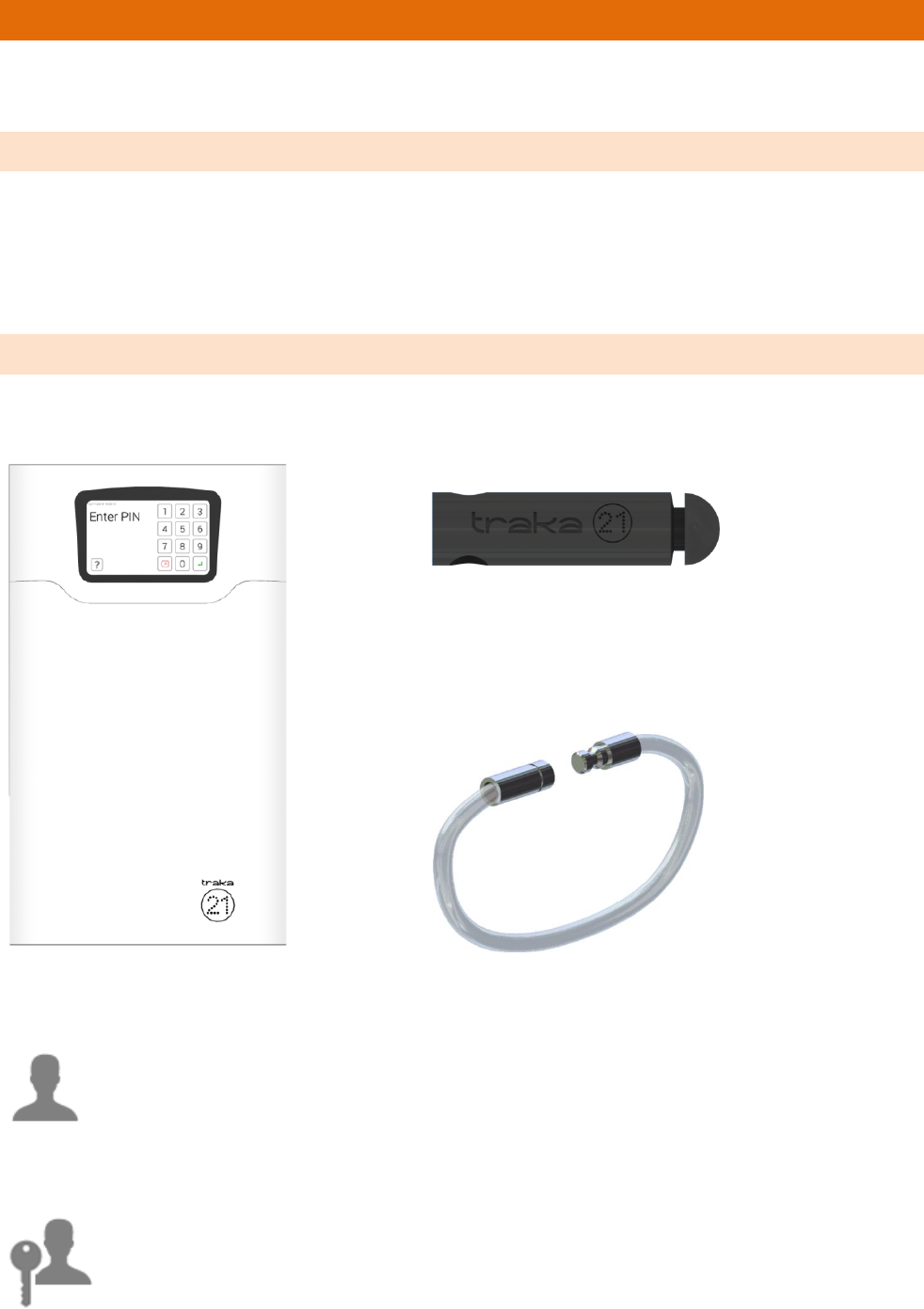
V1.2 09/01/15 UD0130 Page 6 of 63
1. INTRODUCTION
This User Guide has been prepared to assist you (the end user) with the operating basics of the Traka21. Please keep
this guide handy for those times when you need to remember how to Add Users, Add Keys or run Reports.
1.1 SUMMARY OF TRAKA21
Traka21’s innovative plug and play system provides small to medium size businesses with the very latest in intelligent
key management.
Simple, efficient and cost-effective, Traka21 helps trace and account for every key or keyset, which are individually
locked in place, ensuring that critical business operations are never jeopardised.
1.2 GLOSSARY OVERVIEW
Users – Users are added to the system by an administrator and can either be a standard user or another
administrator. This is done from the user wizard in the admin section of the Traka21.
Permissions – The permissions section of the Traka21 allows you to easily identify who has access to what keys and
allows you to edit each user’s permission.
System – The term ‘System’ refers
to the Traka21 unit.
iFob – The iFob is the heart of the Traka21 system. It contains
a small RFID chip which allows the system to identify the
keys(s) attached.
Security Seal – The Security Seal is used to attach the key(s) to
the iFob. Once the seal has been crimped, the only way to
detach the keys from the iFob is to cut the security seal using a
pair of heavy duty cutters.
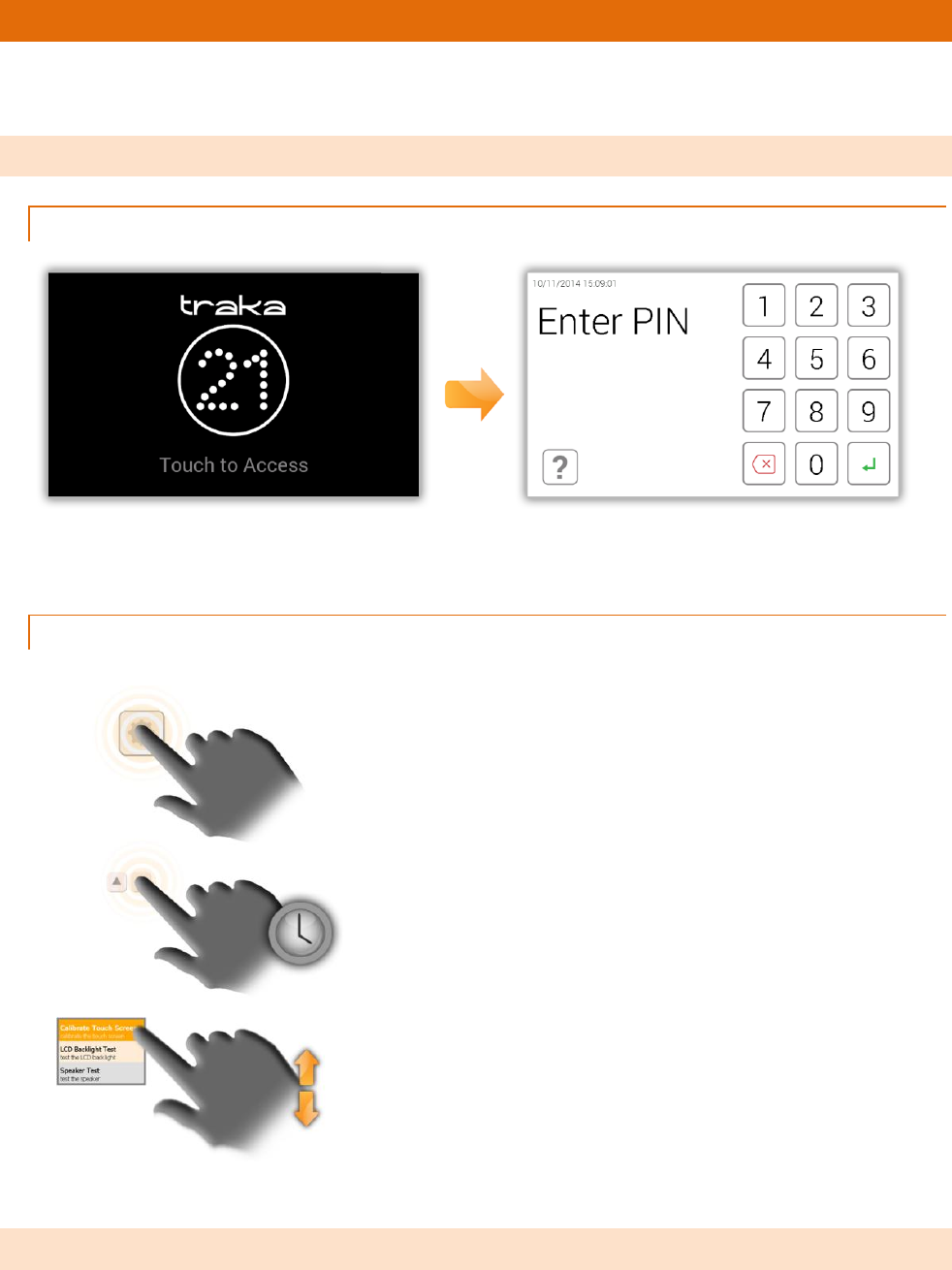
V1.2 09/01/15 UD0130 Page 7 of 63
2. TRAKA21 OVERVIEW
The Traka21 system uses touch screen technology for an easy, user friendly interface. Traka21 does not require the
use of a stylus or any other navigation device, to use the system simply click on the desired buttons with your finger.
2.1 THE TOUCH SCREEN
2.1.1 SCREEN SAVER
If the Traka21 system is not active for 30 seconds, then the system will go into ‘power save’ mode. To use the
system again simply press anywhere on the touch screen.
2.1.2 TOUCH COMMANDS
2.2 IDENTIFICATION
The Traka21 is a PIN only entry system. The minimum PIN length must be at least four digits long, and the maximum
length is ten digits.
Click – Selecting an onscreen button then
immediately releasing will activate it.
Click & Hold – Selecting and holding certain
directional buttons will cycle through menus and
various options.
Scroll – Swiping up and down on a list or menu in will
scroll through.
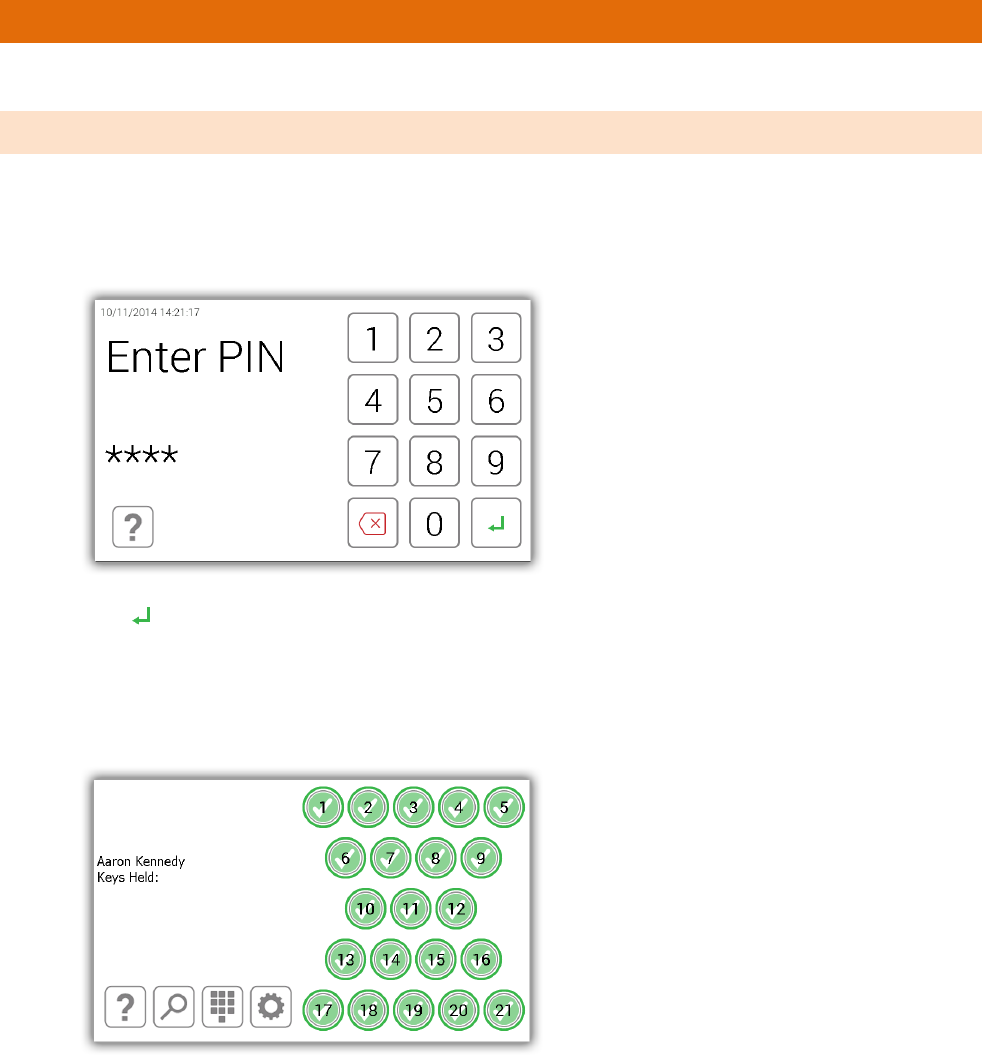
V1.2 09/01/15 UD0130 Page 8 of 63
3. USING THE SYSTEM
To use Traka21 a user with the correct credentials must login at the system.
3.1 LOGGING INTO THE SYSTEM
1. Touch the screen to bring the system out of power save mode.
2. Enter your PIN.
3. Press (enter) to confirm your PIN.
4. The door will then open allowing you access to the keys.
5. Verify your name on the touch screen.
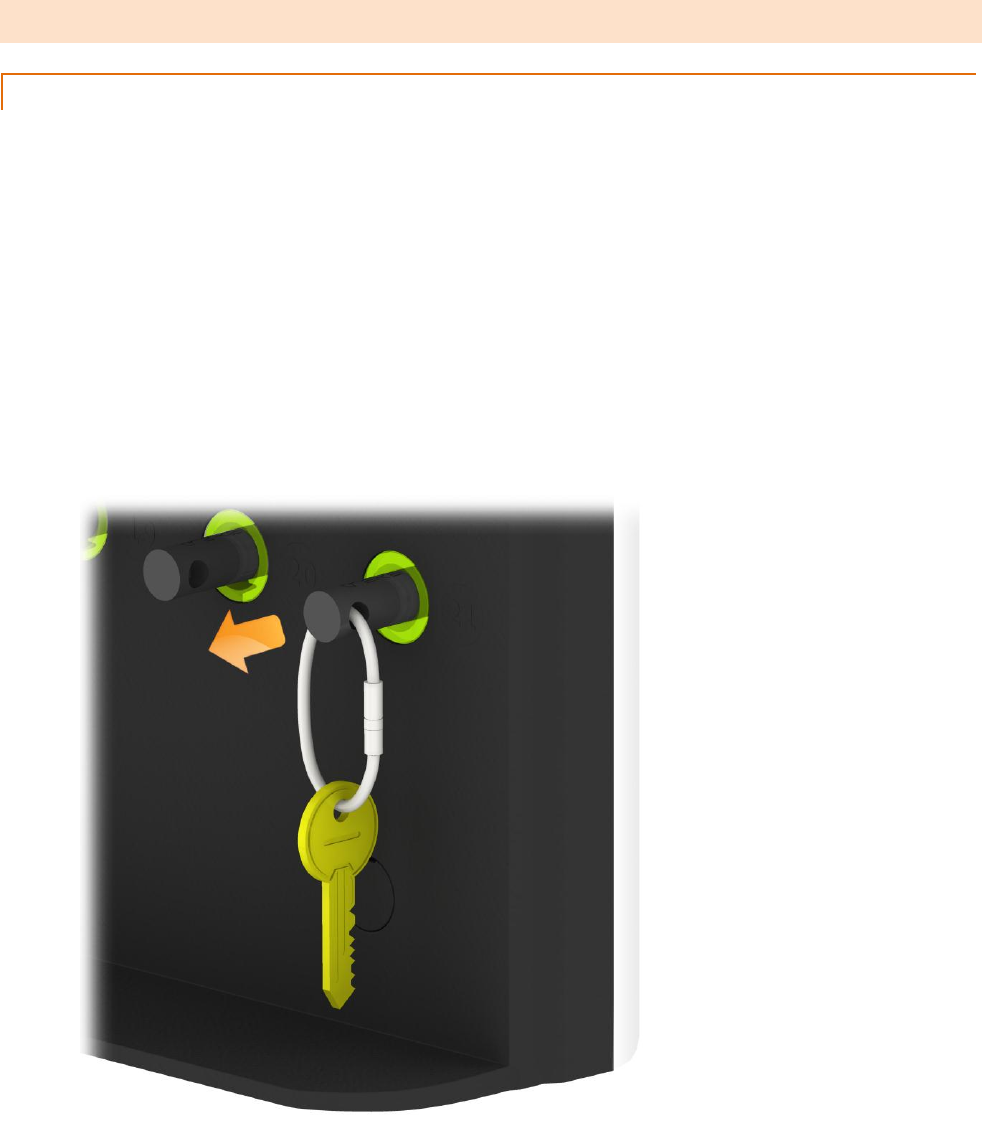
V1.2 09/01/15 UD0130 Page 9 of 63
3.2 REMOVING & RETUNING KEYS
3.2.1 REMOVING KEYS
Removing a key is a one handed operation.
1. Enter your PIN at the system.
2. The door will open.
3. Authorised iFob slots will be illuminated green.
Unauthorised iFob slots will be illuminted red.
4. Press the on screen button for the iFob you wish to remove.
5. Wait for the “click” (unlocking iFob).
6. Remove iFob.
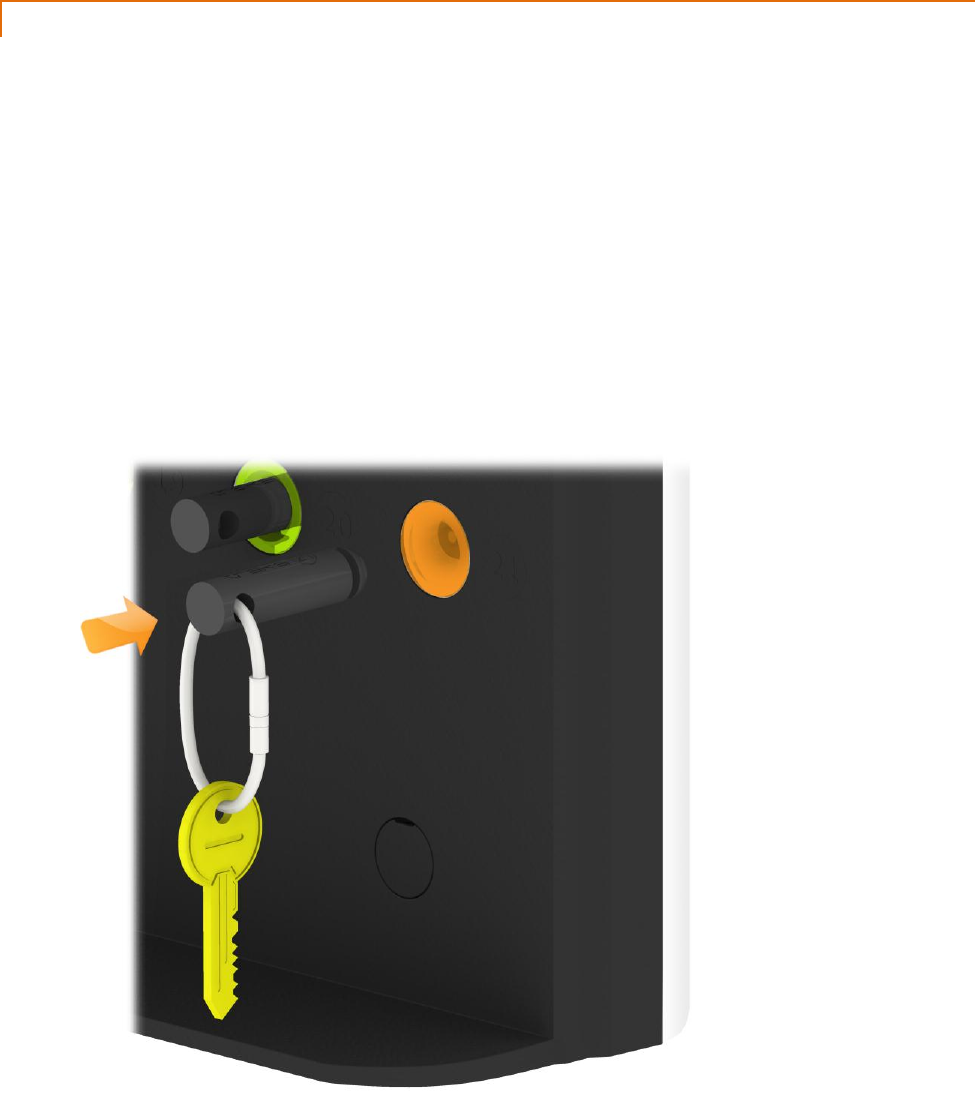
V1.2 09/01/15 UD0130 Page 10 of 63
3.2.2 RETURNING KEYS
You must return the key to the correct receptor slot.
1. Enter your PIN at the system.
2. The door will open.
3. Positions illuminated Orange indicate the iFobs held by the current user.
4. Insert iFob into matching receptor slot.
NOTE: If you return the iFob to the incorrect slot, the touch screen will notify you and request that you
remove the key and return it to the correct slot as indicated. The positions in the system will also
illuminate and guide you to the correct position.
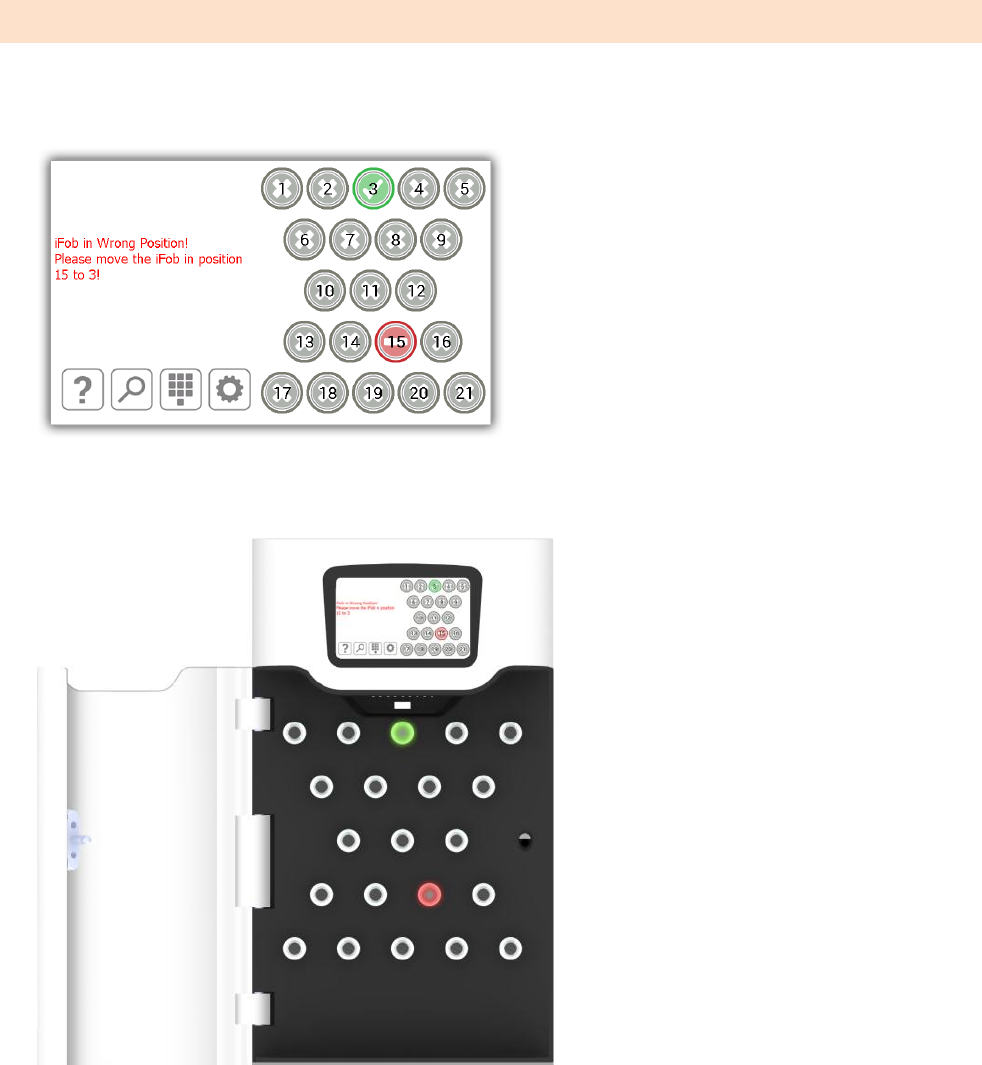
V1.2 09/01/15 UD0130 Page 11 of 63
3.3 IFOB IN WRONG SLOT
When an iFob is returned to the incorrect position the system will prompt you to remove the iFob from the incorrect
position and return it to the correct position.
In addition to the touch screen giving you instructions, the receptor positions will illuminate and guide you to the
correct slot as shown below.
NOTE: This is a configurable option that can be selected on or off for all users in the general settings of Traka21.
Please view section 4.8 for more details.
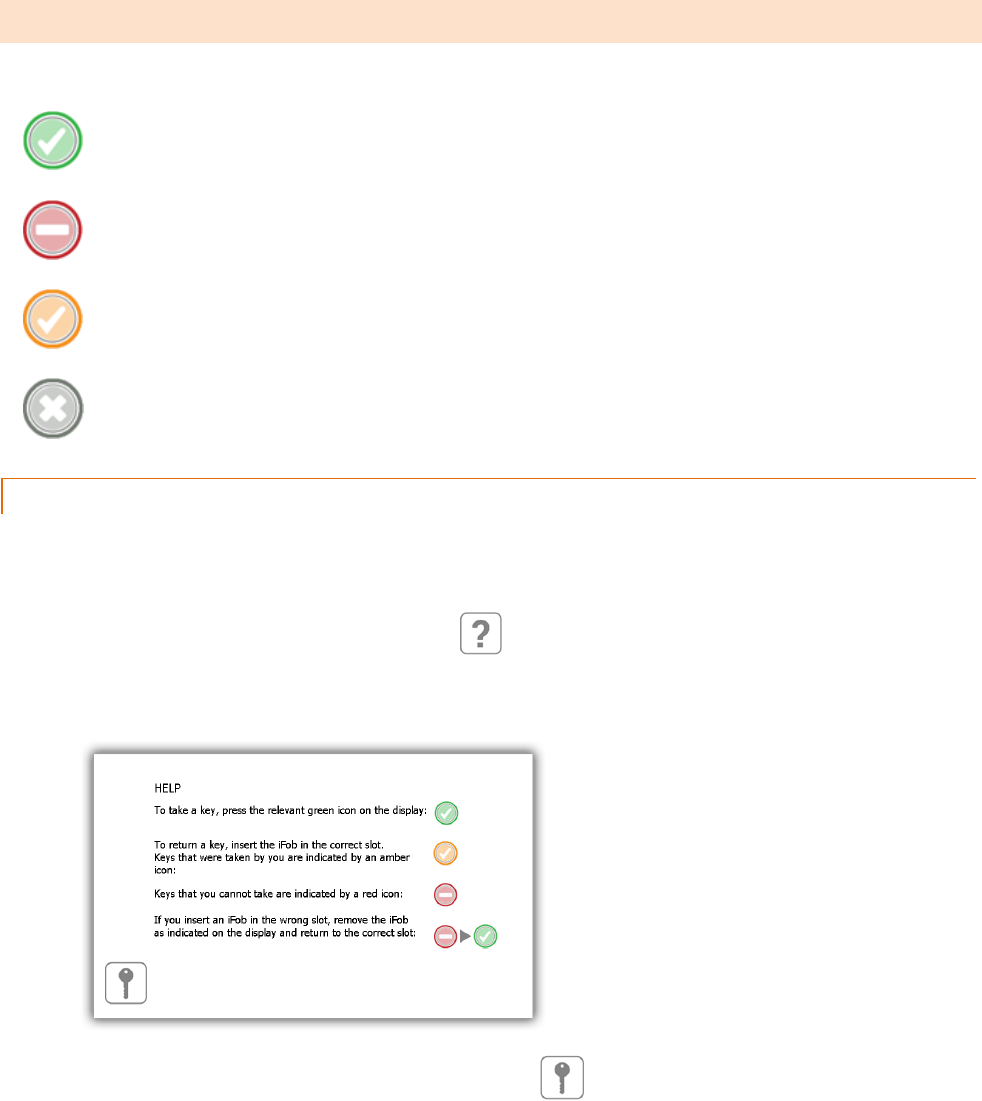
V1.2 09/01/15 UD0130 Page 12 of 63
3.4 IFOBS STATUS ICONS
Please see below descriptions of each iFob status in the Traka21 system.
The green circle with a white tick symbol indicates that the user has access to the iFob.
The red circle with a white line shows that the user does not have access to the iFob
The orange circle with a white tick indicates that the iFob is out of the system to the currently logged in user.
The grey circle with a white cross shows that the iFob is out of the system to another user.
3.4.1 HELP
Whilst a user is logged in they can click the help button for information on the iFob stats and at what point they can
take a key.
1. Click the help button from the logged in screen
2. The help screen will then appear giving details on which iFobs a user can or can’t take.
3. To get back to the logged in screen click the keys button
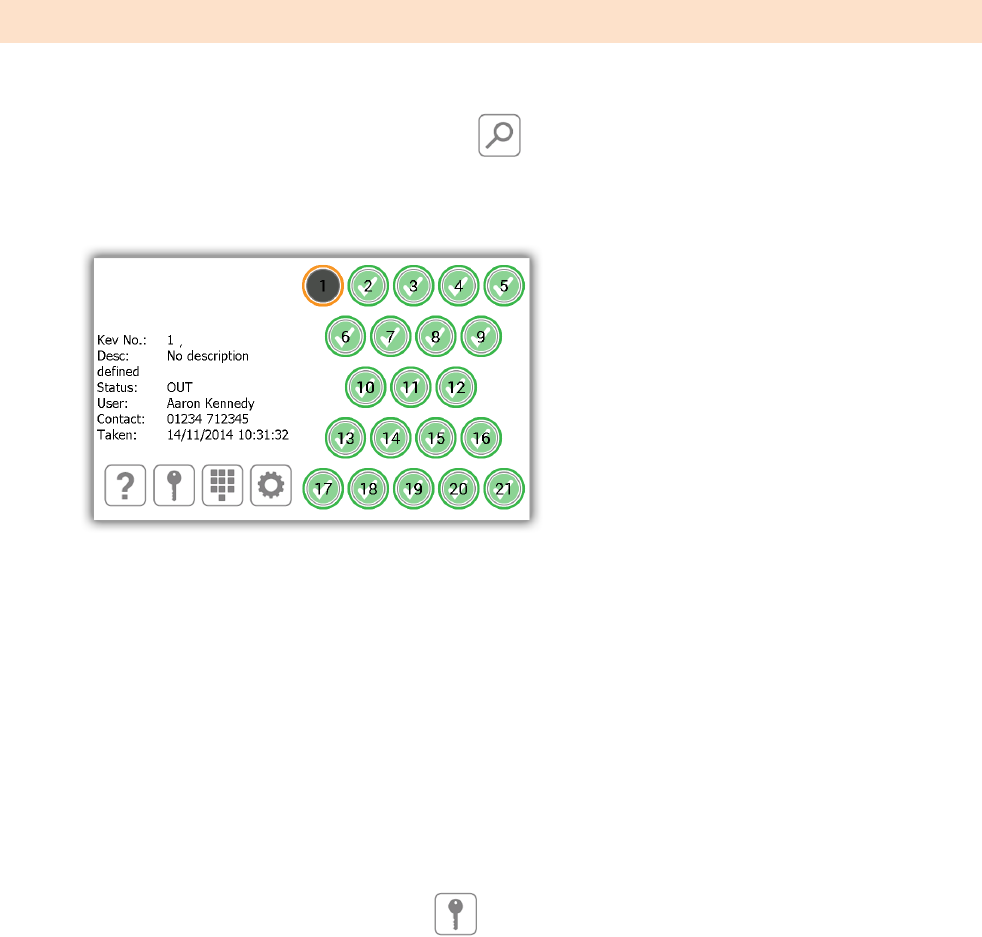
V1.2 09/01/15 UD0130 Page 13 of 63
3.5 IFOB LOOKUP
When a user is logged in they can click the search icon and look up the details of an iFob.
1. Click the search button from the logged in screen
2. Select which key you wish to search for.
The search will detail the following information...
The position of the iFob
Any description assigned to the key(s) on the iFob
Whether the iFob is in or out of the system
If the iFob is out of the system, this will display the user who currently has the iFob. If the iFob is in,
this will display the user who last returned it.
The users contact information
And the date & time it was last taken or returned.
3. To search again, simply select another iFob position.
4. When you are finished click the keys button and you will be taken back to the logged in screen.
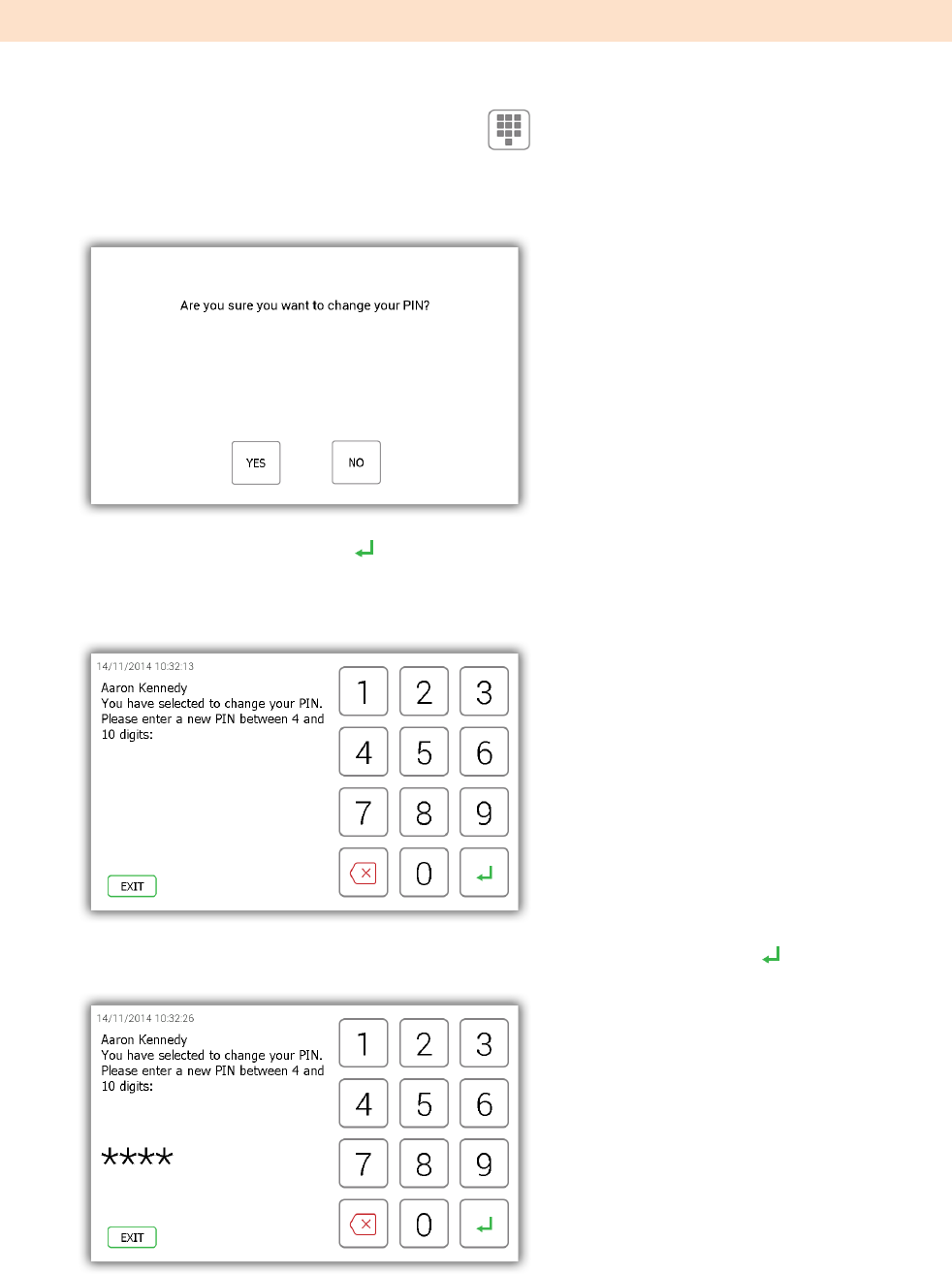
V1.2 09/01/15 UD0130 Page 14 of 63
3.6 CHANGE PIN
A user can change their PIN by selecting the change PIN button once they have logged in.
1. Click the change PIN icon from the logged in screen
2. A message will appear asking if you wish to change your PIN. Click Yes.
3. Enter your new PIN and click enter .
NOTE: your PIN must be at least four digits long but can be no longer than ten.
4. You will be prompted to enter your new PIN a second time for clarification. Click enter .
5. A message will be displayed stating your PIN change was successful. You will then be taken back to the login
screen.
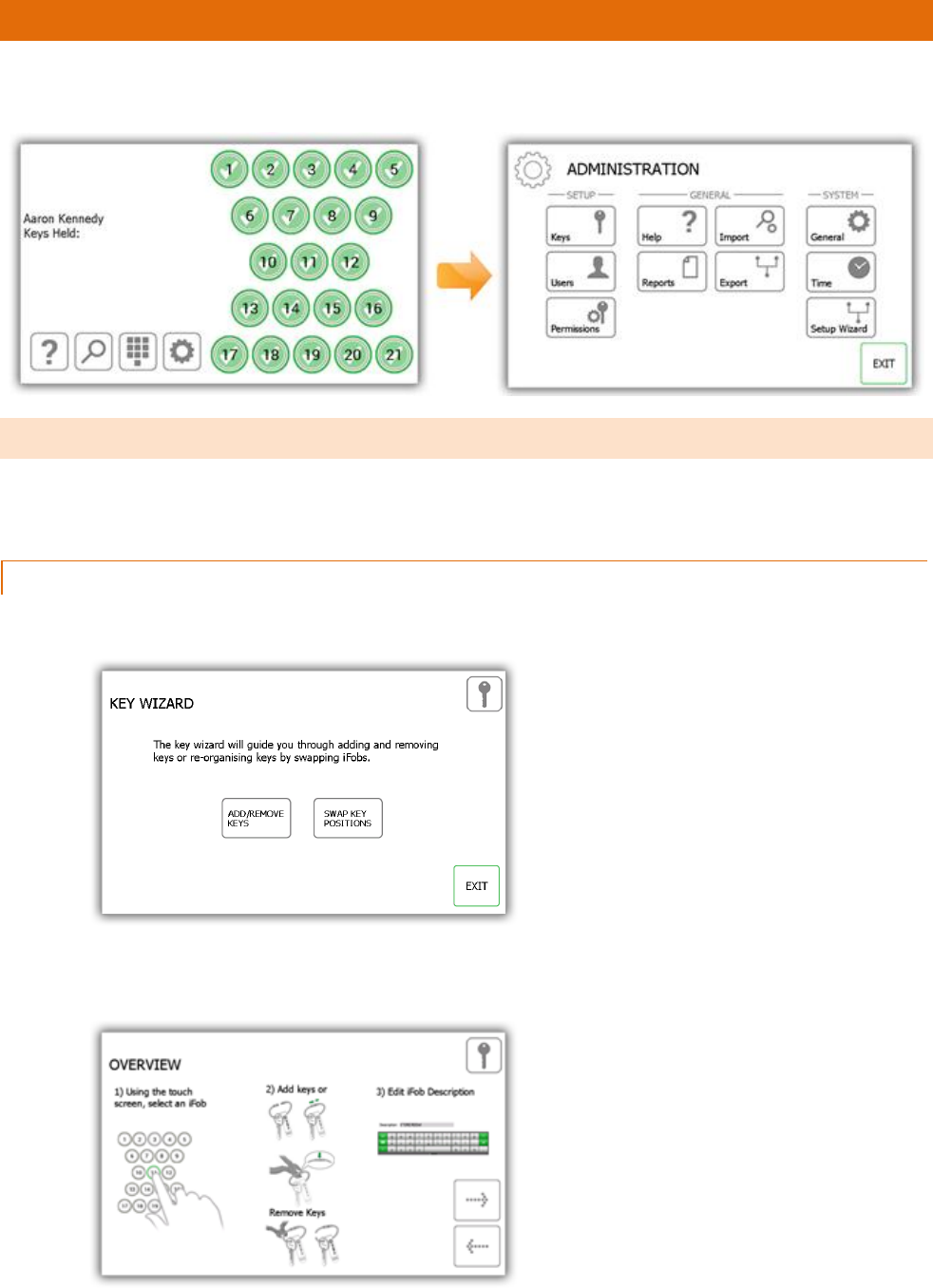
V1.2 09/01/15 UD0130 Page 15 of 63
4. ADMIN MENU
This section of the user guide will take you through the admin menu and all of its features. To access the admin menu,
a user with admin access will need to identify themselves at the system and select the admin button.
4.1 KEYS
From the admin menu select the Keys button. The key wizard will allow you to add/remove keys to iFobs in the
system. You can also use the feature swap key positions, which allow you to reorganise the keys in the system.
4.1.1 ADDING/REMOVING KEYS
1. Select the Add/Remove Keys button from the key wizard menu.
2. The overview screen will appear providing you instructions on how to add keys to an iFob. Read these
instructions and click the forward button.
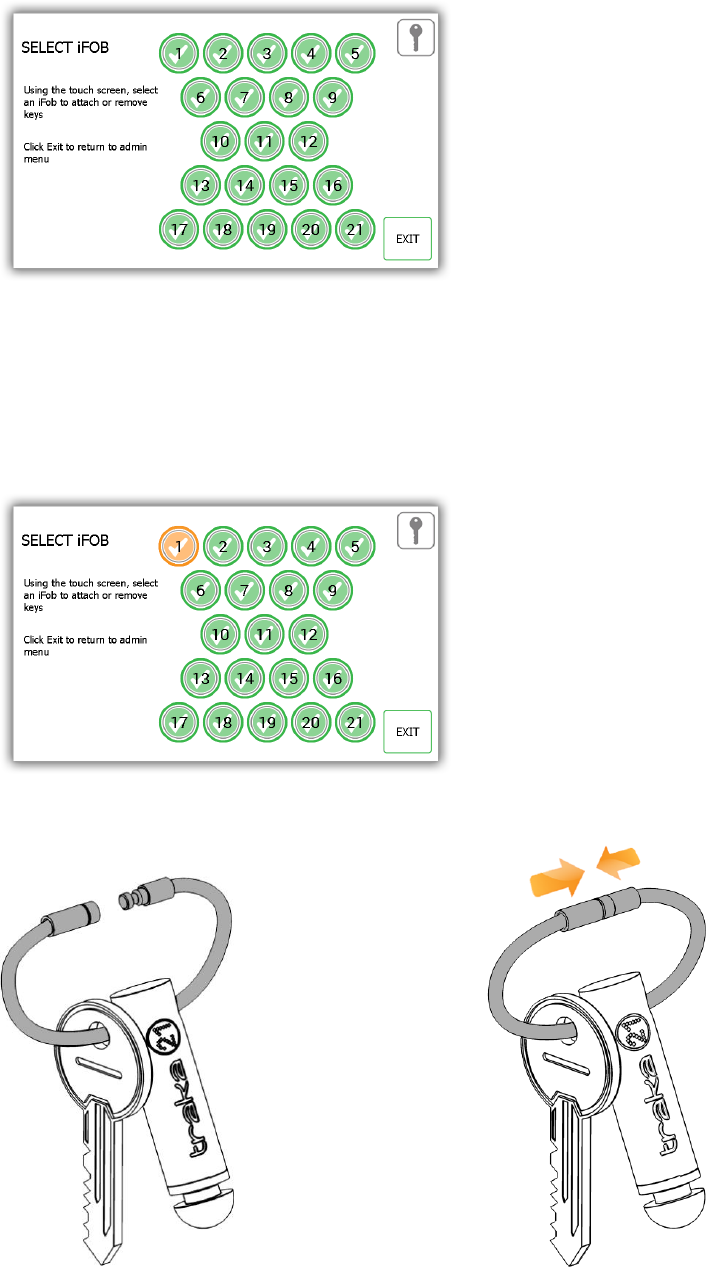
V1.2 09/01/15 UD0130 Page 16 of 63
3. Select the desired iFob using the touch screen.
4. The iFob will then be released from the system.
NOTE: If at any time you wish to exit the Key Wizard, close the door or select the Exit button.
5. Remove the iFob from the system. The touch screen will display an orange ‘removed’ icon for the iFob you
have taken.
6. Now the iFob is out of the system, you can attach your key(s) using the provided Security Seal.
A
B
Put you’re your
key(s) onto the
security seal
with the iFob.
Push the seal
together.

V1.2 09/01/15 UD0130 Page 17 of 63
7. You will be prompted to enter a description for the key(s). Click save when you have finished.
8. When you have finished, return the iFob to the system. The orange ‘removed’ icon will now become green
again as you have returned it to the system.
9. To add more keys to an iFob, simply select another iFob from the touch screen.
10. When you are finished adding keys, click the exit button to be taken back to the admin menu or close the
door.
Crimp this line gently with a
pair of scissors.
ENSURE THAT YOU DO NOT
CUT THROUGH THE
SECURITY SEAL
C
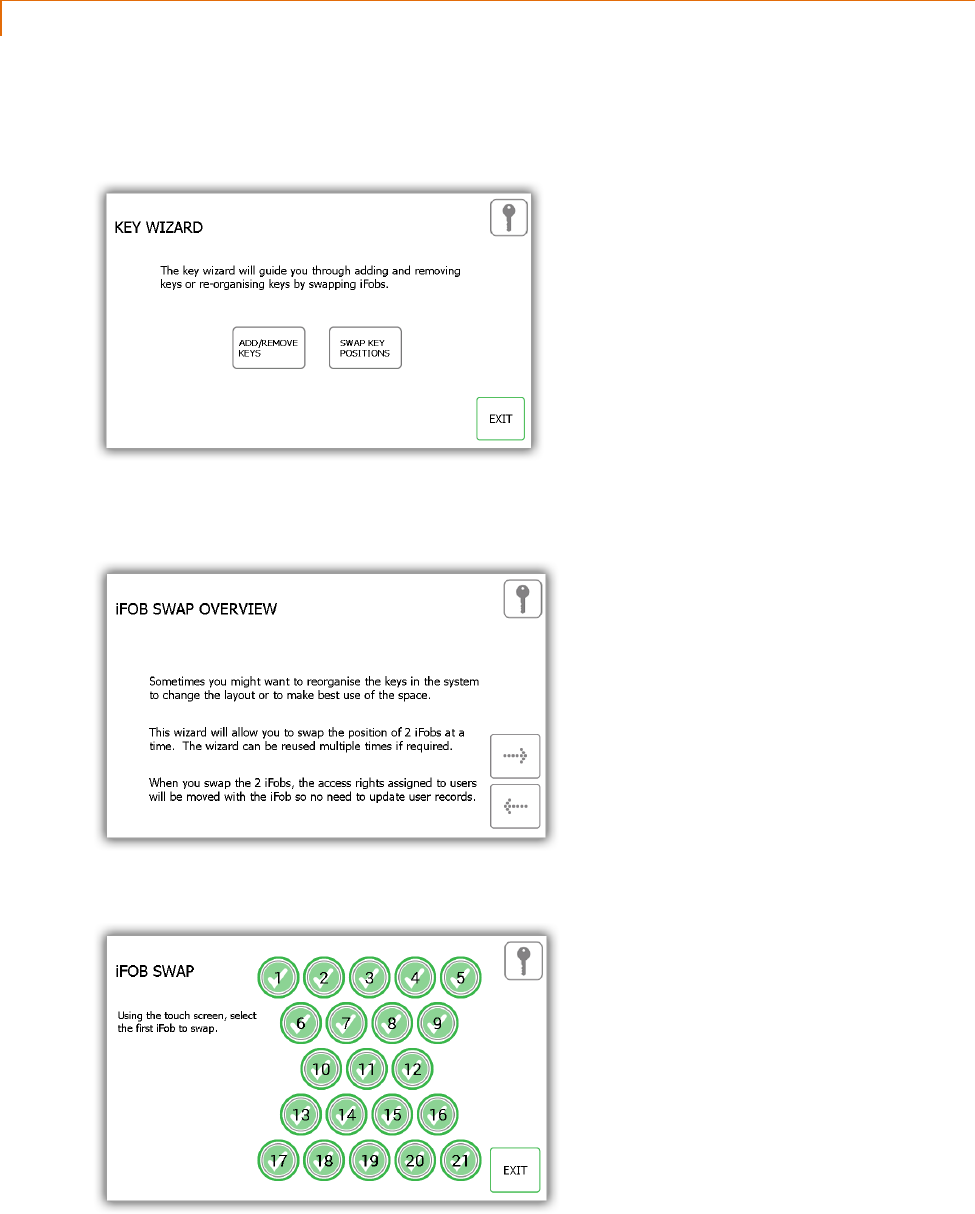
V1.2 09/01/15 UD0130 Page 18 of 63
4.1.2 SWAP KEY POSITIONS
The swap key positions feature is very beneficial if you wish to reorganise the keys in the system. Using the swap key
feature, you won’t need to cut or re-crimp any security seals; the system will reassign the iFobs to new positions.
1. Select the Swap Key Positions button from the key wizard menu.
2. The swap key overview will then appear giving you a description of how the feature works. Read this and click
the forward arrow.
3. Select the first of the two positions you want to swap over.
4. The iFob will then release to you. Put it safely to one side.
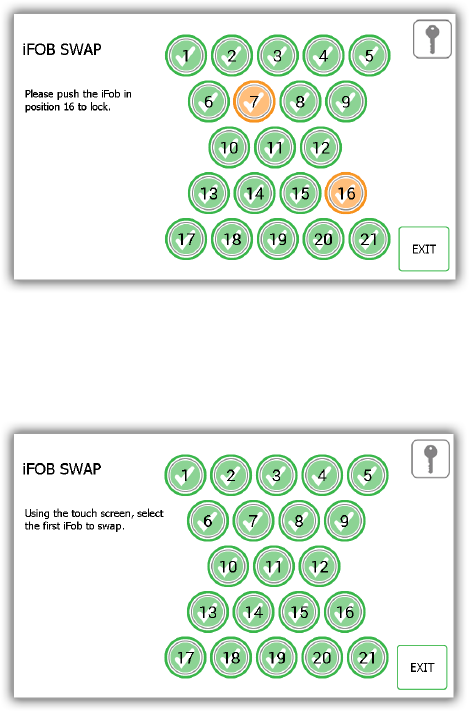
V1.2 09/01/15 UD0130 Page 19 of 63
5. Select the second iFob and it will release from the system.
6. Now that both iFobs are out of the system, you can return them to the system in their new positions.
7. The system will recognise the swap and will accept both iFobs.
8. To swap more Fobs simply being this process again from step 3.
9. When you are finished click the exit button to return to the admin menu or close the door.
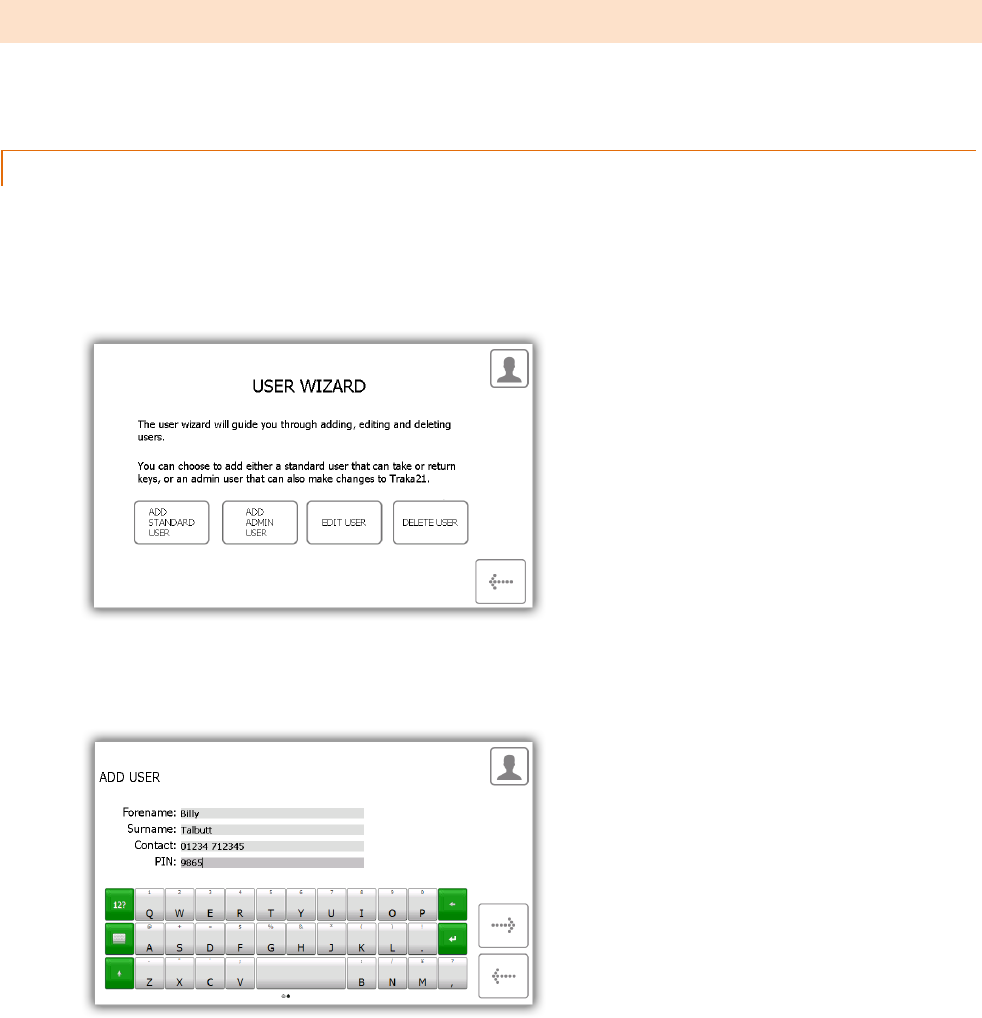
V1.2 09/01/15 UD0130 Page 20 of 63
4.2 USERS
From the admin menu click the user’s button. To add, edit or delete a user, login to the system and navigate to the
admin menu. From the admin menu select the user’s button.
4.2.1 ADDING A STANDARD USER
A standard user does not have access to the admin menu or any reports. This user will only be able to remove and
return keys. When the User Wizard appears you will have many options to choose from.
1. Select the Add Standard User button.
2. The user details window will appear allowing you to enter the user’s forename, surname, contact number
and PIN. Enter the details and click the forward button.
Contact – This field is for a phone number, fax number, email or any means of contact that the
user is reachable by.
PIN – The PIN (personal identification number) is the numeric password that will grant you access
into the system. It must be between four and ten digits long.
3. Next you will need to select the user’s permissions. Using the touch screen simply select which iFobs the user
will have access too. The green circles with white ticks show positions the user currently has access to. To
remove access, simply click the button to turn it to a red circle with a white line. When you have finished click
the forward button.
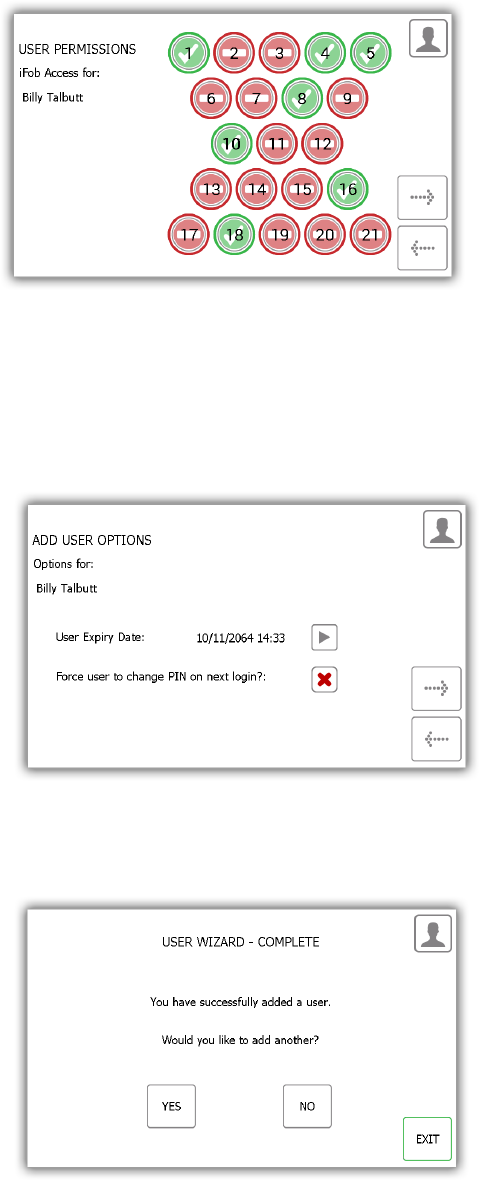
V1.2 09/01/15 UD0130 Page 21 of 63
4. At the options page you can set the following...
User Expiry Date – Here you can set the date and time the users profile expires and becomes
inactive at the system.
Force user to change PIN on next login? – enabling this option will force the user to change their PIN
when they next attempt to log onto the system.
Select the appropriate features and click the forward arrow.
5. The user wizard is now complete. A message will appear stating that you have successfully added a user.
6. If you want to add more users click yes and you will be taken to a new user details screen. Follow steps 2-5
again.
7. If you are finished and do not want to add any more users click no and you will be taken back to the Admin
menu. From there click exit again to return to the login screen.
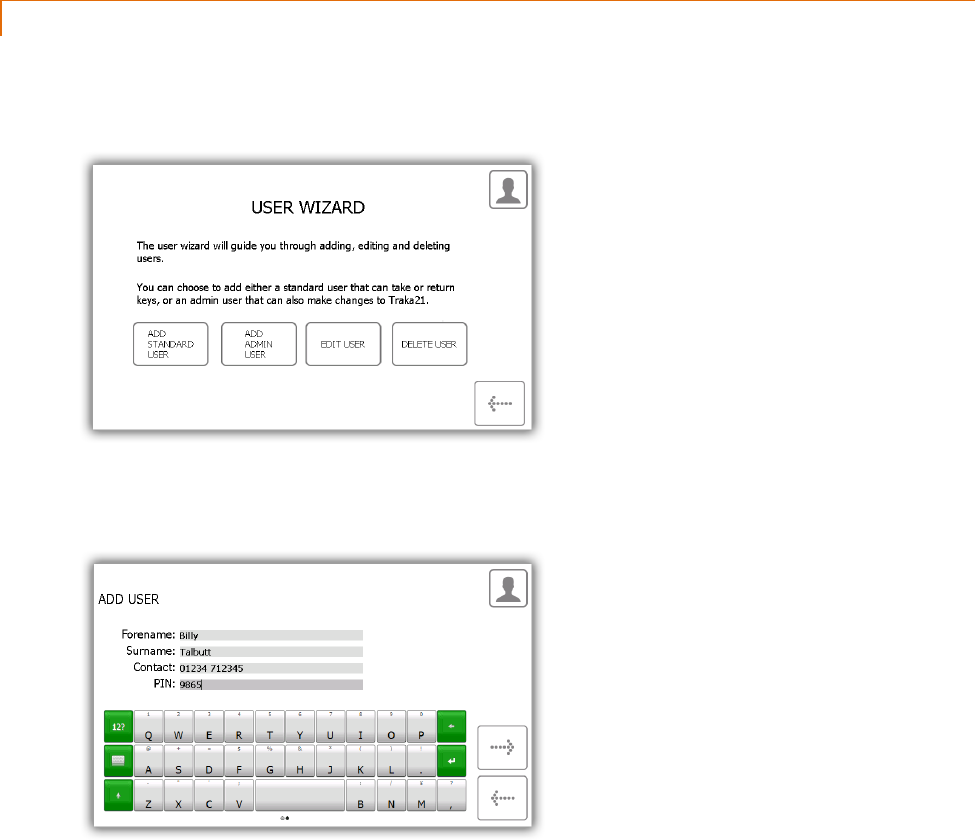
V1.2 09/01/15 UD0130 Page 22 of 63
4.2.2 ADDING AN ADMIN USER
An admin user can remove and return keys as well as access the admin menu and run reports.
1. Select the Add Admin User button.
2. The user details window will appear allowing you to enter the user’s forename, surname, contact number
and PIN. Enter the details and click the forward button.
Contact – This field is for a phone number, fax number, email or any means of contact that the
user is reachable by.
PIN – The PIN (personal identification number) is the numeric password that will grant you access
into the system. It must be between four and ten digits long.
3. Next you will need to select the user’s permissions. Using the touch screen simply select which iFobs the user
will have access too. The green circles with white ticks show positions the user currently has access to. To
remove access, simply click the button to turn it to a red circle with a white line. When you have finished click
the forward button.
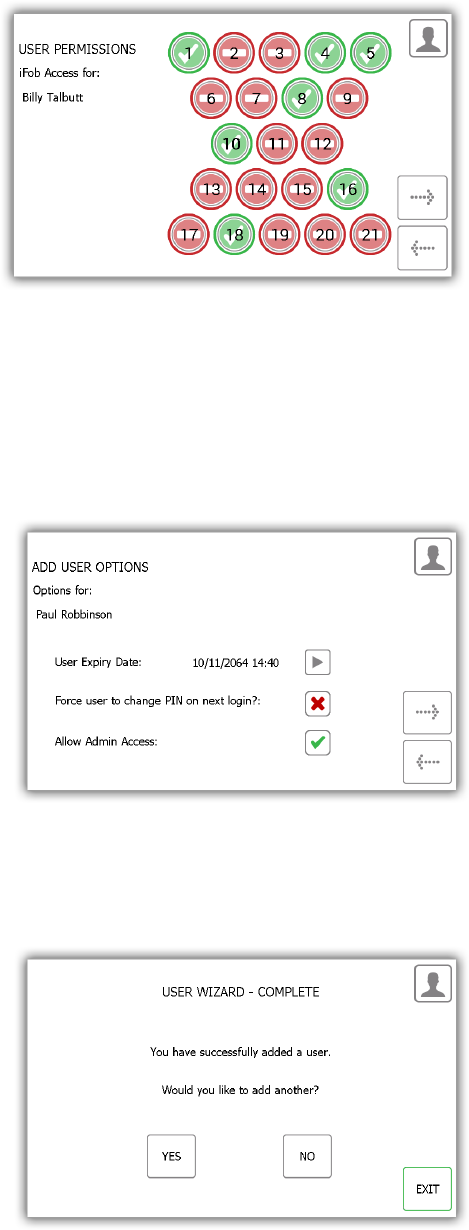
V1.2 09/01/15 UD0130 Page 23 of 63
At the options page you can set the following...
4.
User Expiry Date – Here you can set the date and time the users profile expires and becomes
inactive at the system.
Force user to change PIN on next login? – enabling this option will force the user to change their PIN
when they next attempt to log onto the system.
Select the appropriate features and click the forward arrow.
5. The user wizard is now complete. A message will appear stating that you have successfully added a user.
6. If you want to add more users click yes and you will be taken to a new user details screen. Follow steps 2-5
again.
7. If you are finished and do not want to add any more users click no and you will be taken back to the Admin
menu. From there click exit again to return to the login screen.
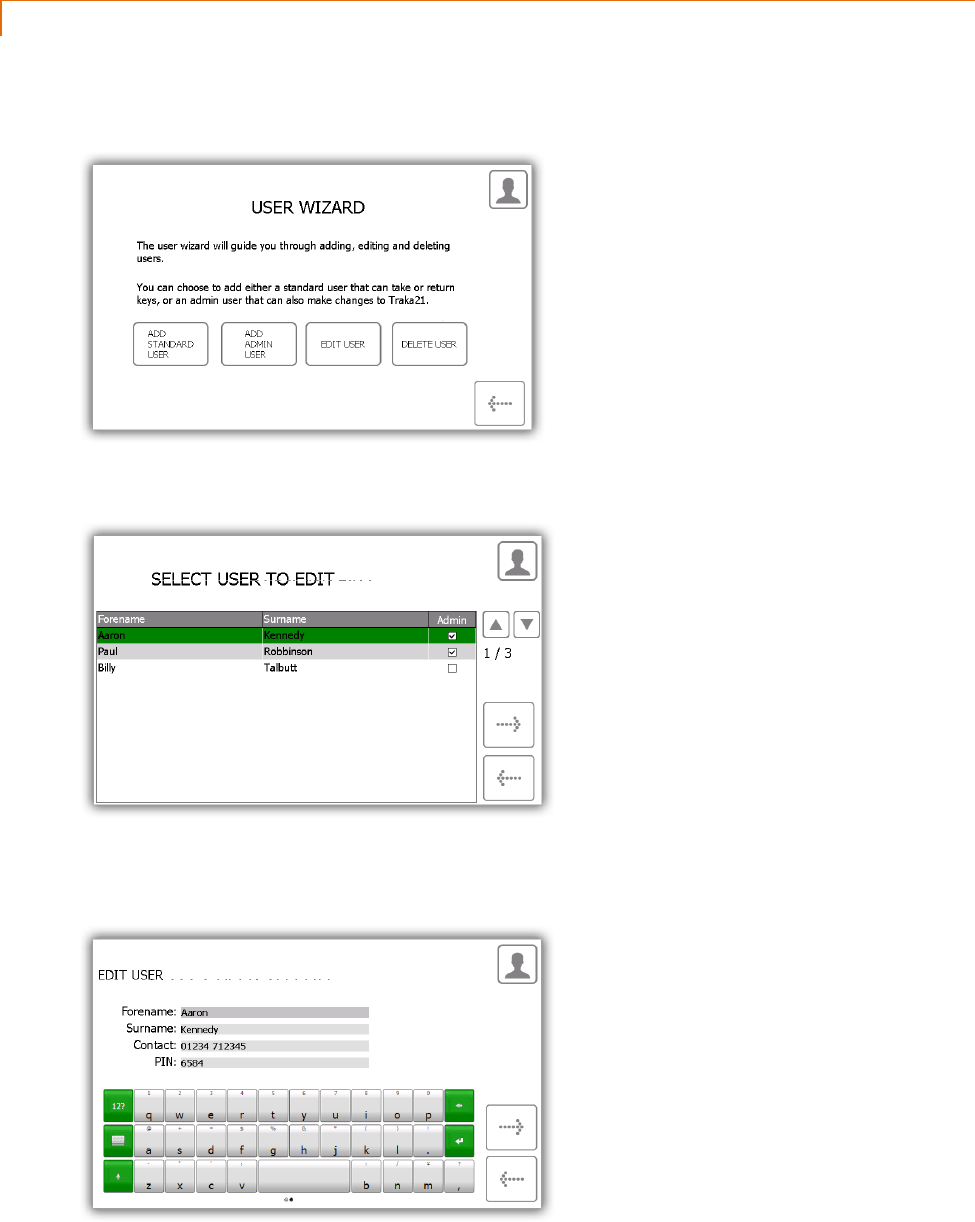
V1.2 09/01/15 UD0130 Page 24 of 63
4.2.3 EDIT USERS
You can edit a user’s details...
1. Select the Edit User button.
2. The current user list will appear. Highlight the desire user and click the forward button.
3. The user’s forename, surname, contact and PIN will then appear. Make any changes you need and click the
forward arrow.
4. Next edit the key permissions by selecting the positions the user may or may not have access to.
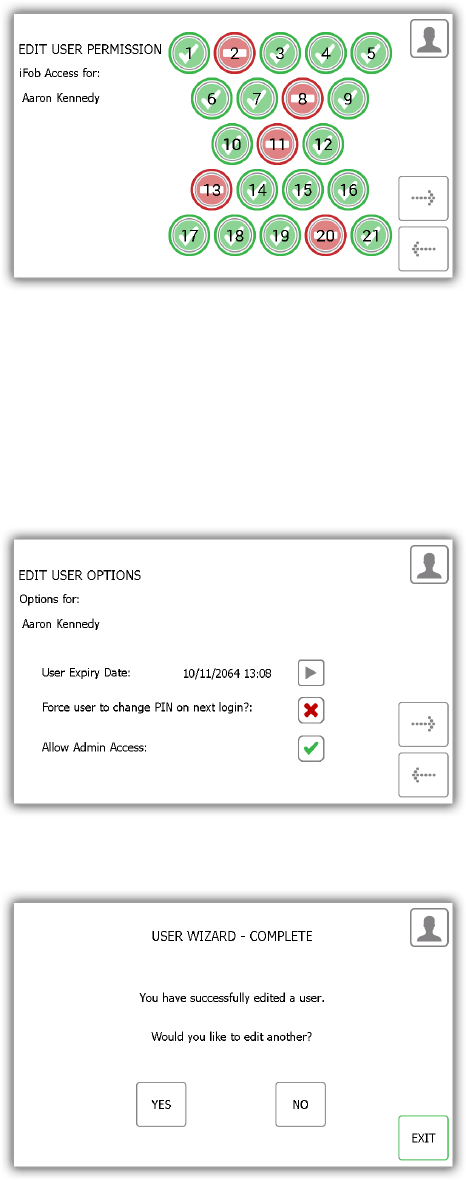
V1.2 09/01/15 UD0130 Page 25 of 63
5. Next edit the user options. Here you can...
Change the expiry date of the user.
Select/deselect the force user to change PIN option.
Select/deselect Allow admin access option.
Edit the desired options and click the forward button.
6. The edit is now complete. A message will now appear saying you have successfully edited a user.
7. If you want to edit more users click yes and you will be taken to the user list. Follow steps 2-5 again.
8. When you are finished, click the exit button to return to the admin menu.
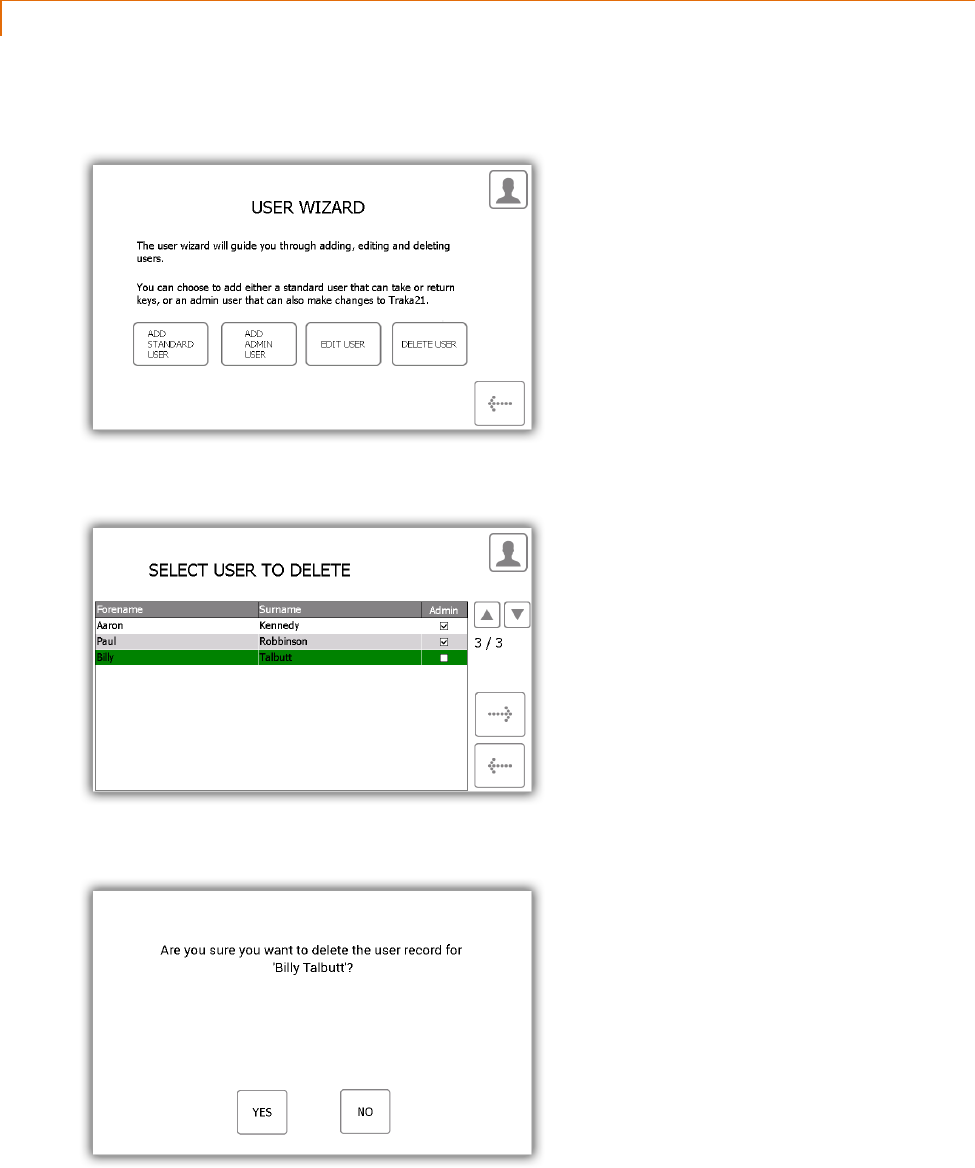
V1.2 09/01/15 UD0130 Page 26 of 63
4.2.4 DELETE USERS
You can delete a user from the system...
1. Select the Delete User button.
2. The current user list will appear. Highlight the desire user and click the forward button.
3. A message will appear asking if you wish to delete the user. Click Yes.
4. The use will now be deleted from the user list.
5. To delete more user repeat steps 2-3.
6. When finished click the back button.
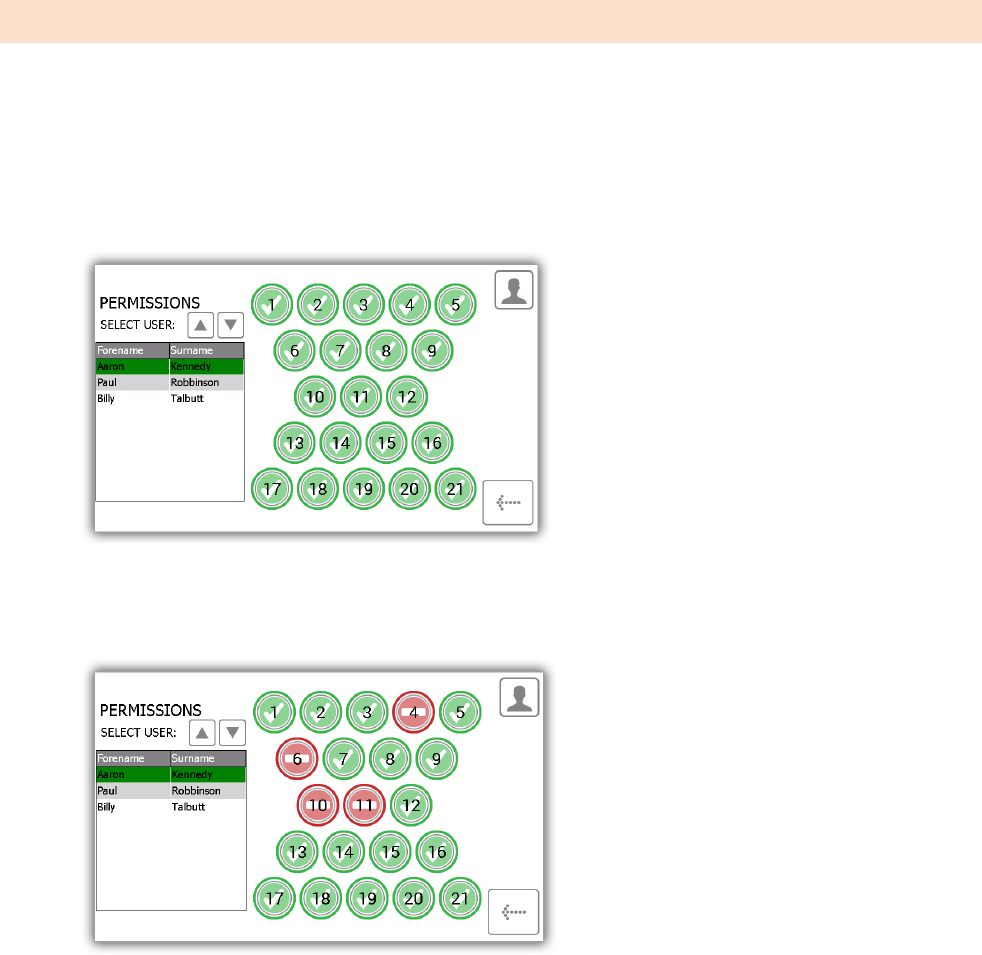
V1.2 09/01/15 UD0130 Page 27 of 63
4.3 PERMISSIONS
From the admin menu select the permissions button. The permissions section allows you to view all the current users
in the system and grant/revoke their access rights without having to edit their individual user details.
1. From the admin menu select the permission button.
2. From the list on the left, highlight the user whose permissions you wish to edit.
3. Simply select the positions you wish the user to have access to.
4. To edit another user simply scroll down highlight the desired user.
5. To go back to the admin menu click the back button.
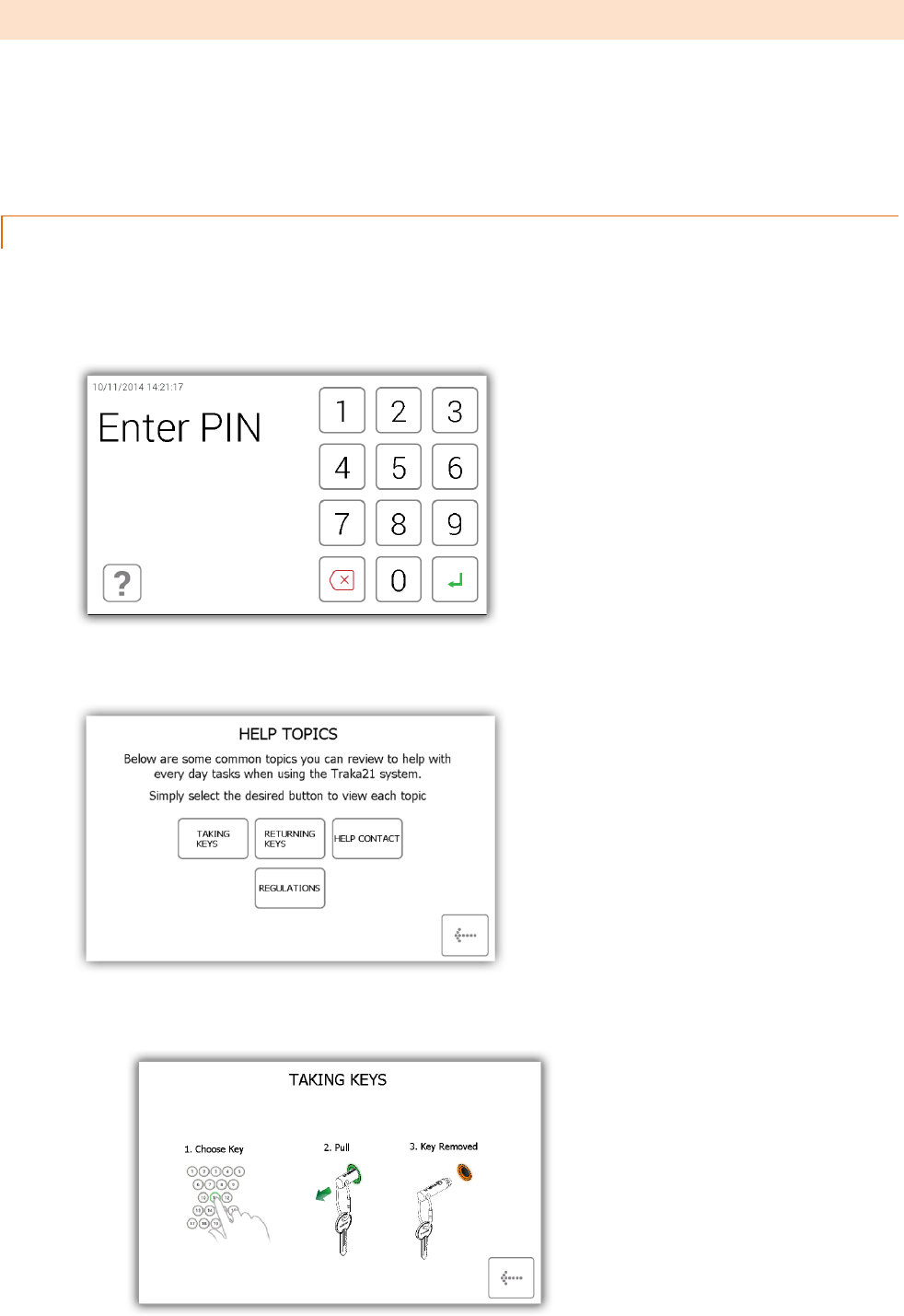
V1.2 09/01/15 UD0130 Page 28 of 63
4.4 HELP
The Traka21 has embedded help topics that will assist you with the everyday tasks of using the system. The help page
can be viewed from two locations, the main login screen and the admin menu. Every user will be able to view the help
page from the login screen; however it will not have all the topics that are available from the admin menu. This has
been done to make it easier for the ‘standard users’ as they will only be able to view the help topics on actions they
can make.
4.4.1 STANDARD USER HELP
A standard user will only have access to the help topics at the login screen of the Traka21.
1. From the main login screen select the help button.
2. When the help screen appears you will have three options to select from.
Taking Keys - Will give you a pictorial overview in three steps on how to remove a key from the
system.
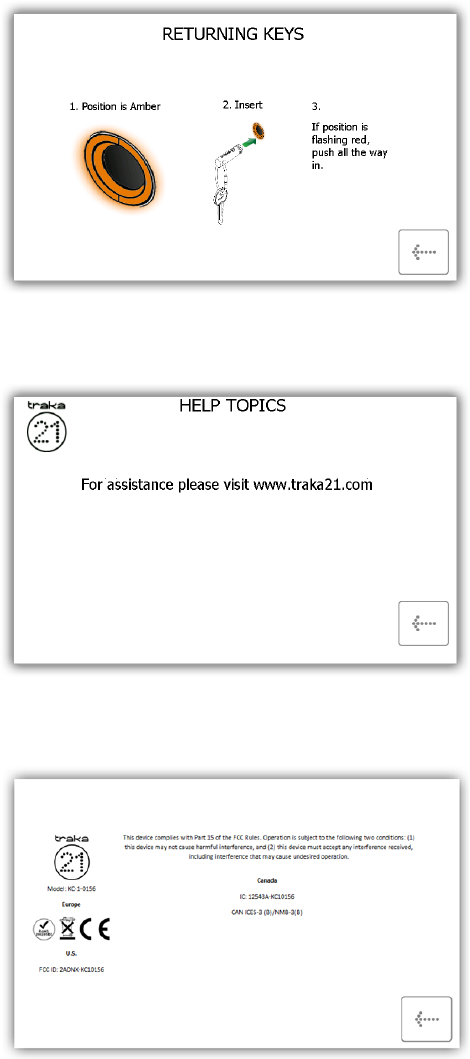
V1.2 09/01/15 UD0130 Page 29 of 63
Returning Keys - Will give you a pictorial overview in three steps on how to return a key to the system.
Help Contact - Will display contact details if you need technical assistance. The details shown here can
be changed by the admin user.
Regulations – This page will give you all the information on the compliances that the Traka21 adheres
to.
3. Select the desired button to open the topic.
4. To return to the help screen, click the back button.
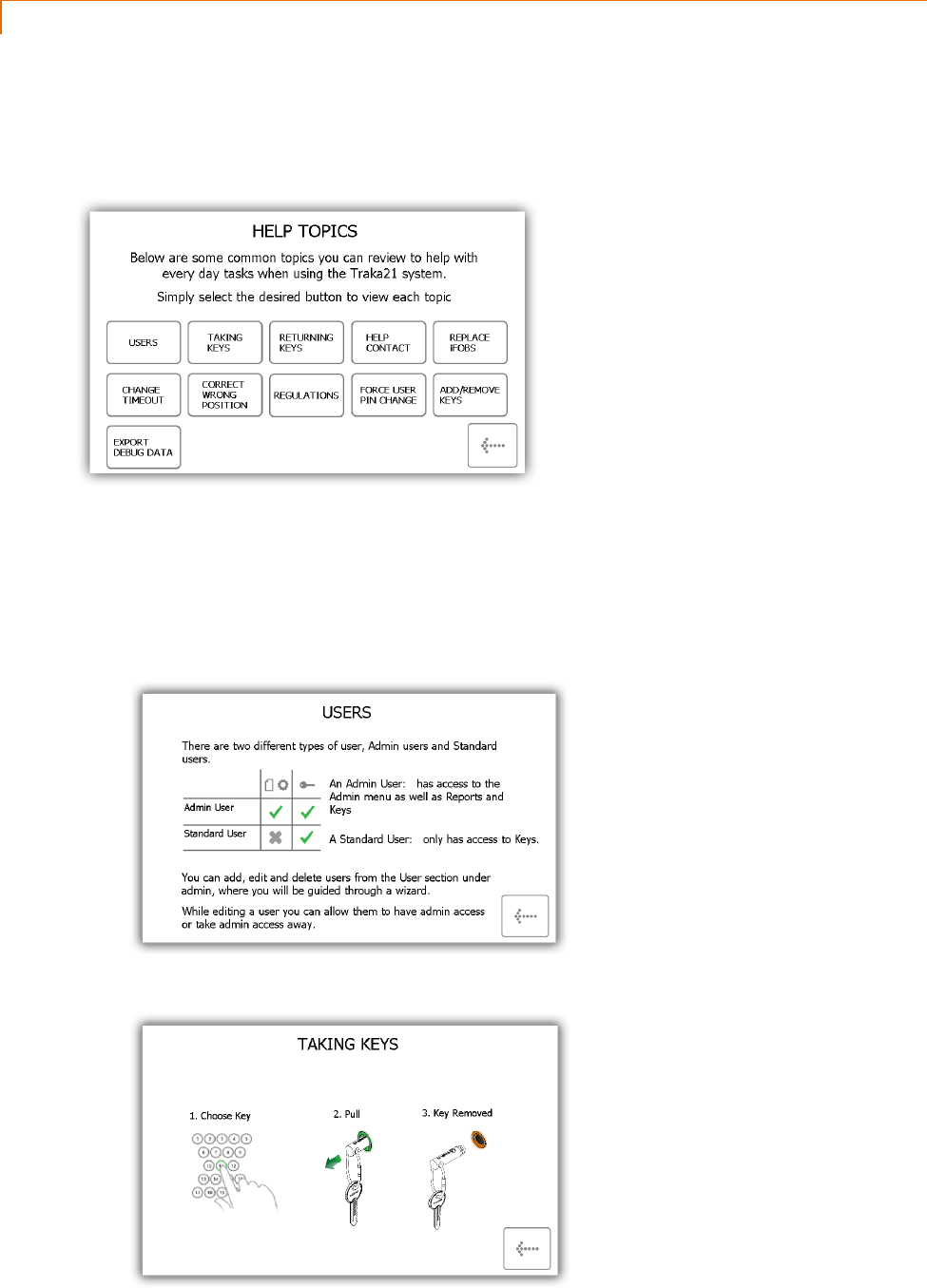
V1.2 09/01/15 UD0130 Page 30 of 63
4.4.2 ADMIN USER HELP
An admin user will be able to see all of the help topics in the system.
1. From the admin menu select the help button.
2. The full list of help topics will then appear.
Users - Explains the difference between standard and admin users and the access they each have.
A standard user does not have access to the admin menu or and reports. This user will only be able to
remove and return keys.
An admin user has access to all aspects of the Traka21 system, users, keys, admin menu and reports.
Taking Keys - Will give you a pictorial overview on how to remove a key from the system.
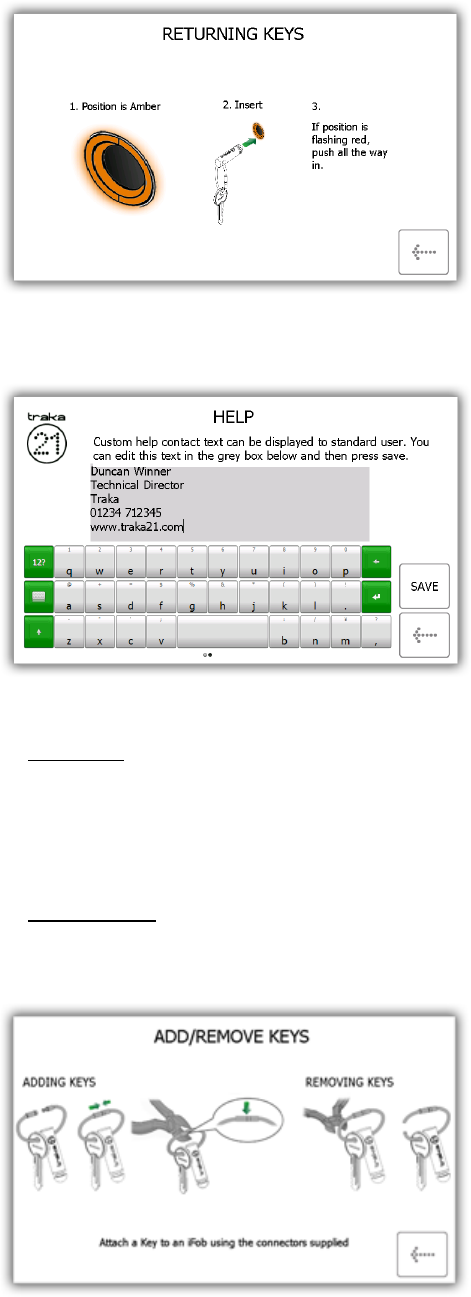
V1.2 09/01/15 UD0130 Page 31 of 63
Returning Keys - Will give you a pictorial overview on how to return a key to the system.
Help Contact – Will allow you to enter new details that change the help section that is displayed to the
standard user .
Add/Remove Keys - Will show you how to add/remove keys to security seals.
To add keys
i) Put you’re your key(s) onto the security seal with the iFob.
ii) Push the seal together
iii) Crimp this line gently with a pair of scissors. ENSURE THAT YOU DO NOT CUT THROUGH THE
SECURITY SEAL.
To remove keys
i) Using a heavy duty cutters, cut the security seal to remove the keys and the iFob.
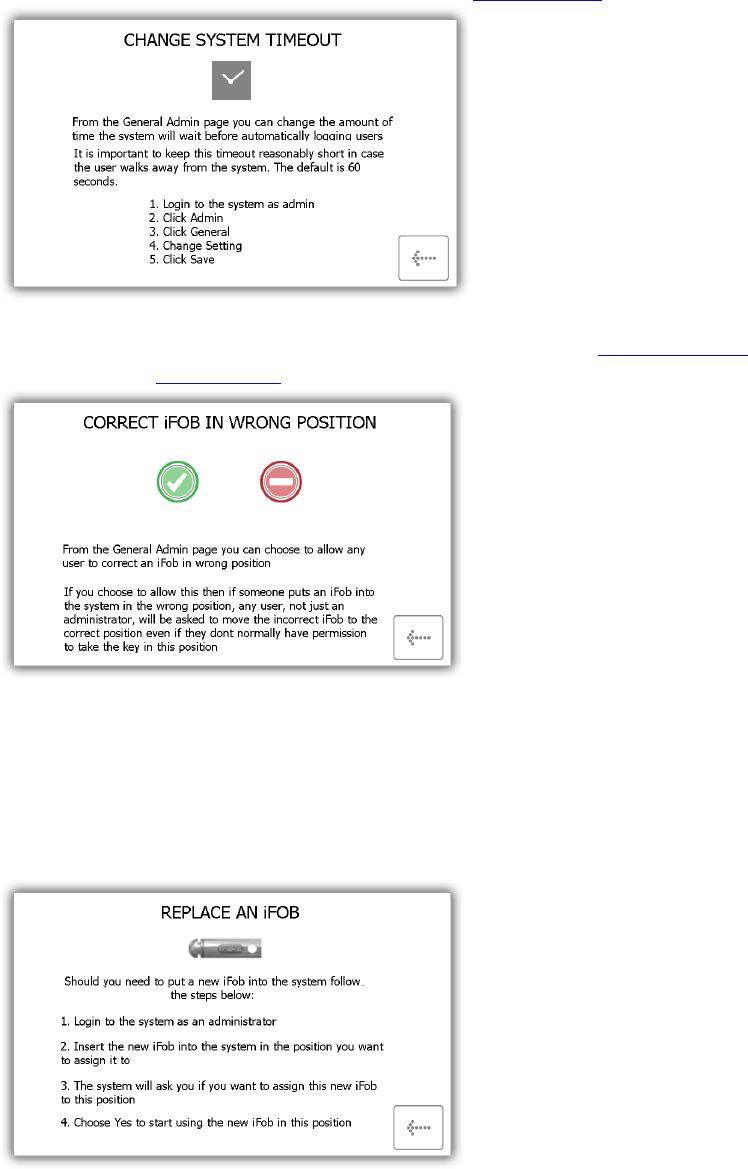
V1.2 09/01/15 UD0130 Page 32 of 63
Change Timeout – The timeout is a user definable period of time that when reached will send the
system into power save mode. This can be changed in the general settings under the admin menu.
Correct Wrong Position - Explains how you can allow a user to correct an iFob in Wrong Slot. This is
definable from the general section.
Replace iFobs – How to replace a broken/lost iFob.
i) Login to the system as an admin.
ii) Insert the new iFob into the position you want to assign it to.
iii) The system will ask you if want to assign this new iFob to this position.
iv) Choose Yes to start using the new iFob in this position.
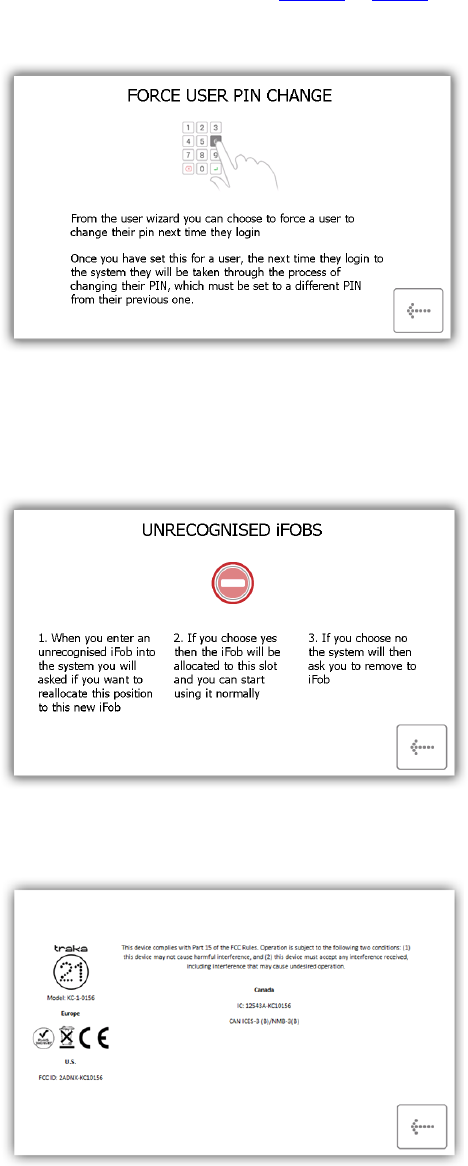
V1.2 09/01/15 UD0130 Page 33 of 63
Force User to Change PIN – when creating or editing a user, the admin user can select an option called
force user to change PIN. This will force that user to change their PIN when they next login.
Unrecognised iFobs – When a user inserts an unrecognised iFob into the system, you will be asked if
you want to reallocate the iFob to the new position. If you choose yes then the iFob will be allocated
and you can use it normally. If you select no then the system will ask you to remove the iFob.
Regulations – This page will give you all the information on the compliances that the Traka21 adheres
to.
3. Select the desired button to open the topic.
4. To return to the help screen, click the back button.
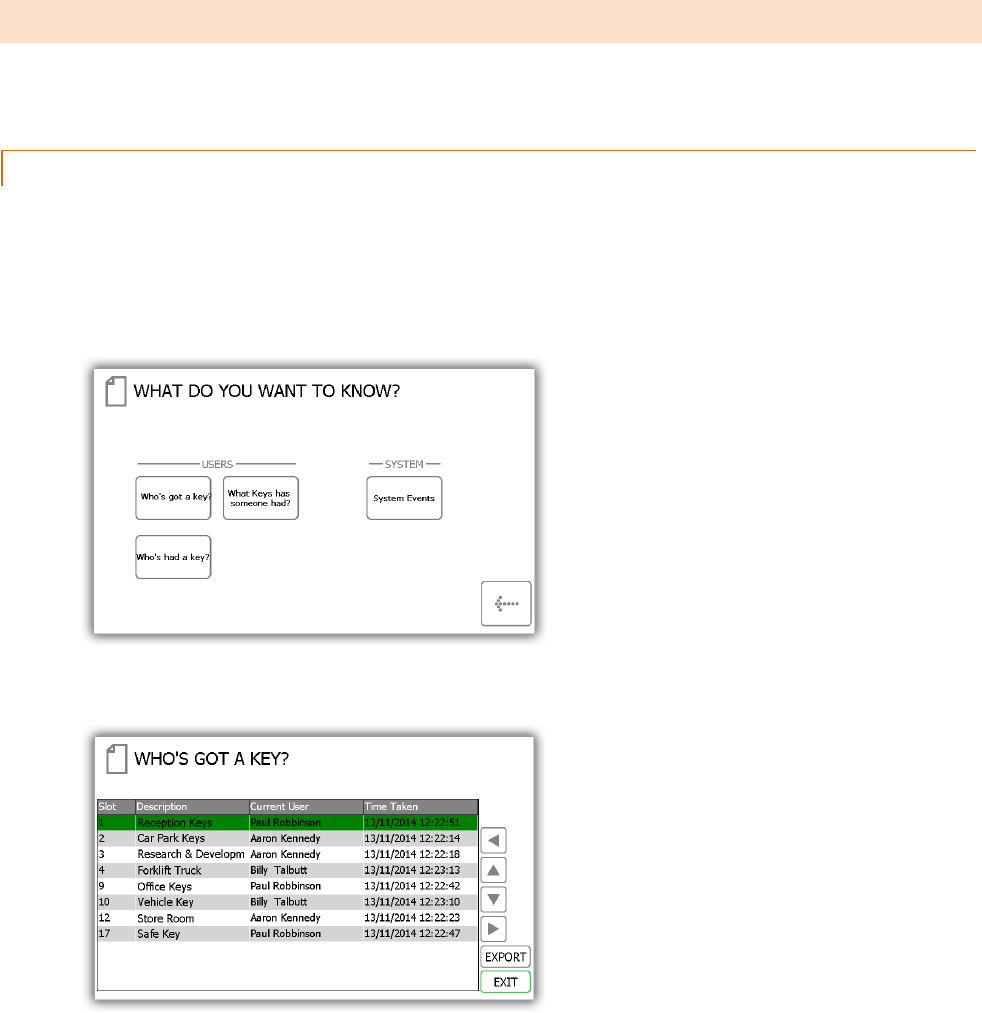
V1.2 09/01/15 UD0130 Page 34 of 63
4.5 REPORTS
From the admin menu select the reports button. Reports allow you to view all the transactions and events that have
occurred at the system.
4.5.1 WHO’S GOT A KEY?
This report will show you who currently has what keys out of the system.
1. From the admin menu select the reports button.
2. In the Users category, select the ‘Who’s got a Key?’ button.
3. Traka21 will then generate a list of all the users who currently have any iFob’s out of the system.
4. You can export this information to a USB memory stick by clicking the Export button. Please review the
Exporting Reports topic at the end of this section for more details.
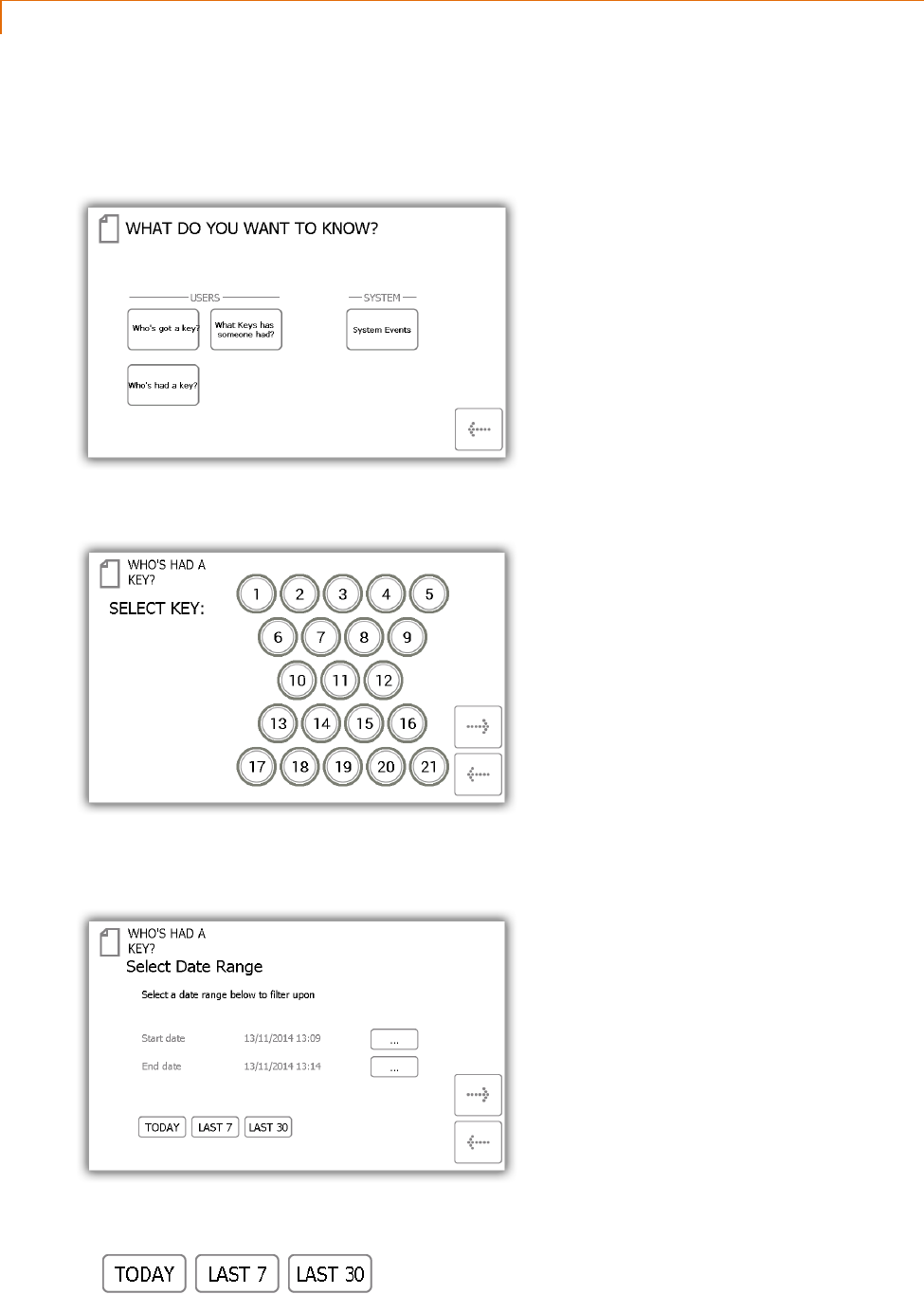
V1.2 09/01/15 UD0130 Page 35 of 63
4.5.2 WHO’S HAD A KEY?
This report will allow you to see the history of a particular key, i.e. which users have had it out of the system.
1. From the admin menu select the reports button.
2. In the Users category, select the ‘Who’s had a Key?’ button.
3. Select the key you wish to view the history of and click the forward button.
4. Next you will need to filter your results by selecting a data range. You can manually enter a start and end
date or use the pre-set buttons at the bottom to automatically enter the date range for you.
The pre-sets buttons will automatically select the date range for you as follows...
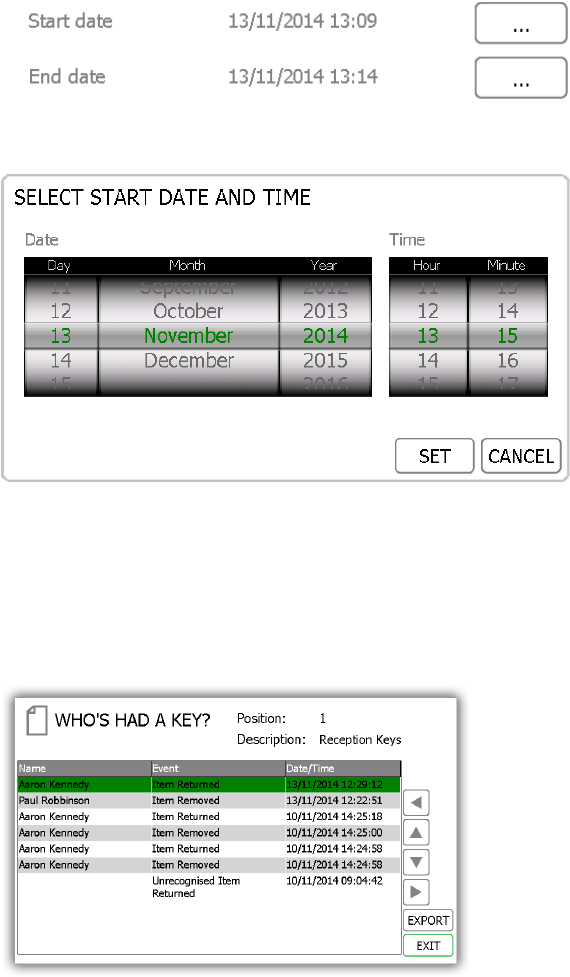
V1.2 09/01/15 UD0130 Page 36 of 63
The ‘Today’ button will provide data for selected report beginning at 00:00 of today’s date and end
at the current time you are running the report.
The ‘Last 7’ button will provide data for the selected report from the last seven days.
The ‘Last 30’ button will provide data for the selected report from the past 30 days.
To manually filter the date range, select the button next to the start or end date.
A scrollable control will now allow you select the exact date and time you wish to run the report on.
5. Once you have selected your desired date range, click the forward button.
6. The report will now generate and display the list of users who have removed the selected key with the date
range.
NOTE: The key position is noted at the top of the page each time the report is run. E.g. position 1.
7. You can export this information to a USB memory stick if you wish by clicking the Export button. Please
review the Exporting Reports topic at the end of this section for more details.
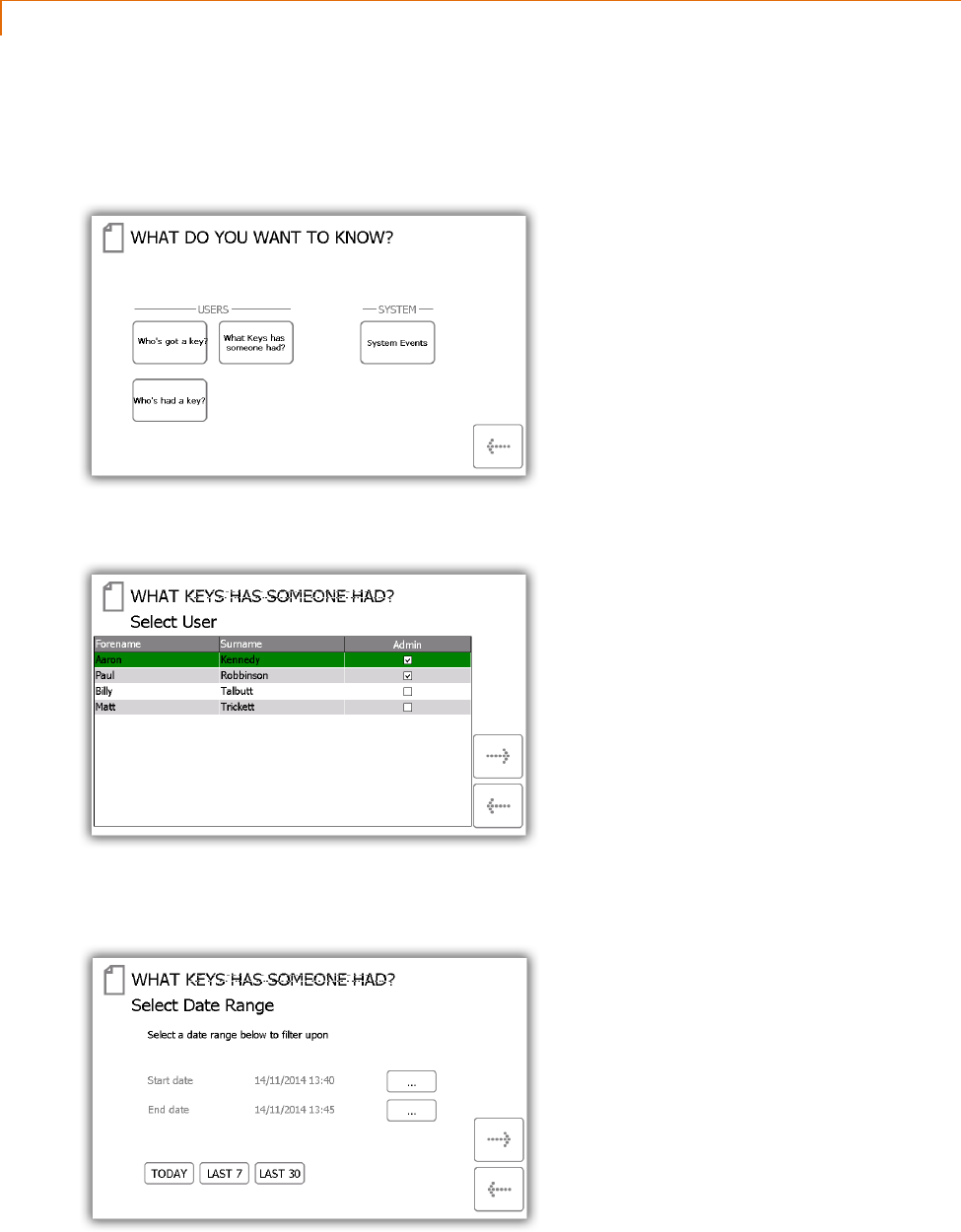
V1.2 09/01/15 UD0130 Page 37 of 63
4.5.3 WHAT KEYS HAS SOMEONE HAD?
This report will allow you to see all the keys a particular user has had out of the system.
1. From the admin menu select the reports button.
2. In the Users category, select the ‘What Keys Has Someone Had?’ button.
3. The current user list will then be displayed. Select the desired user and click the forward arrow.
4. Next you will need to filter your results by selecting a data range. You can manually enter a start and end
date or use the pre-set buttons at the bottom to automatically enter the date range for you.
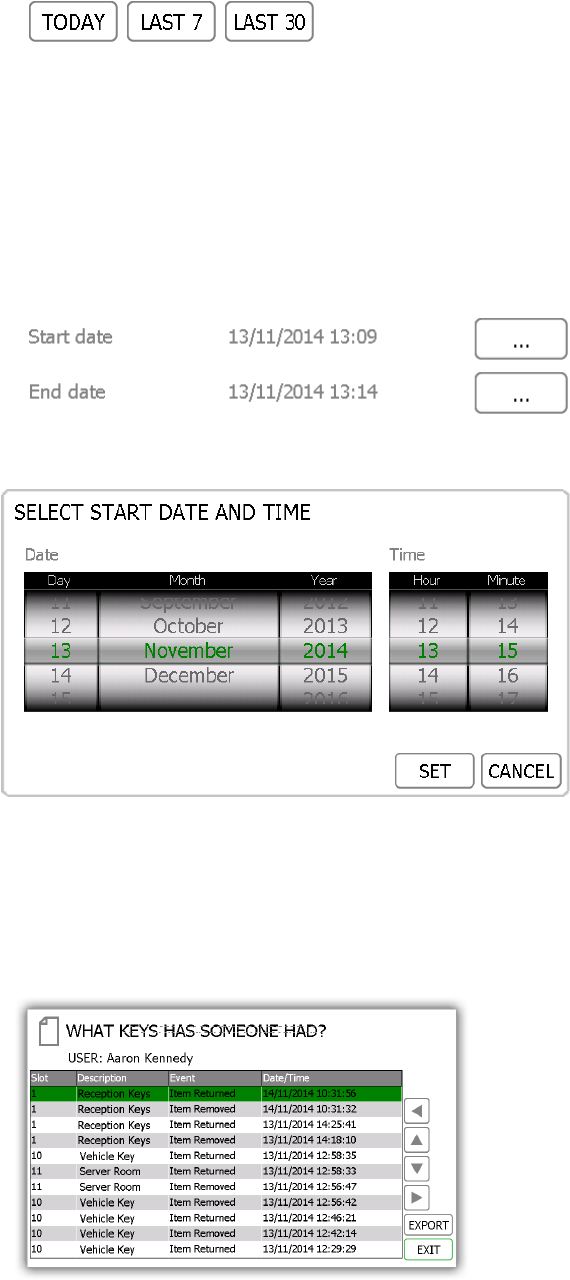
V1.2 09/01/15 UD0130 Page 38 of 63
The pre-set buttons will automatically select the date range for you as follows...
The ‘Today’ button will provide data for selected report beginning at 00:00 of today’s date and end
at the current time you are running the report.
The ‘Last 7’ button will provide data for the selected report from the last seven days.
The ‘Last 30’ button will provide data for the selected report from the past 30 days.
The ‘All’ button will provide data for the selected report from 01/01/2010 00:00 to ensure all events
and transactions are audited.
To manually filter the date range, select the button next to the start or end date.
A scrollable control will now allow you select the exact date and time you wish to run the report on.
5. Once you have selected your desired date range, click the forward button.
6. The report will now generate and display all the keys the specified user has removed between the selected
date range.
NOTE: The key position is noted at the top of the page each time the report is run. E.g. position 1.
7. You can export this information to a USB memory stick if you wish by clicking the Export button. Please
review the Exporting Reports topic at the end of this section for more details.
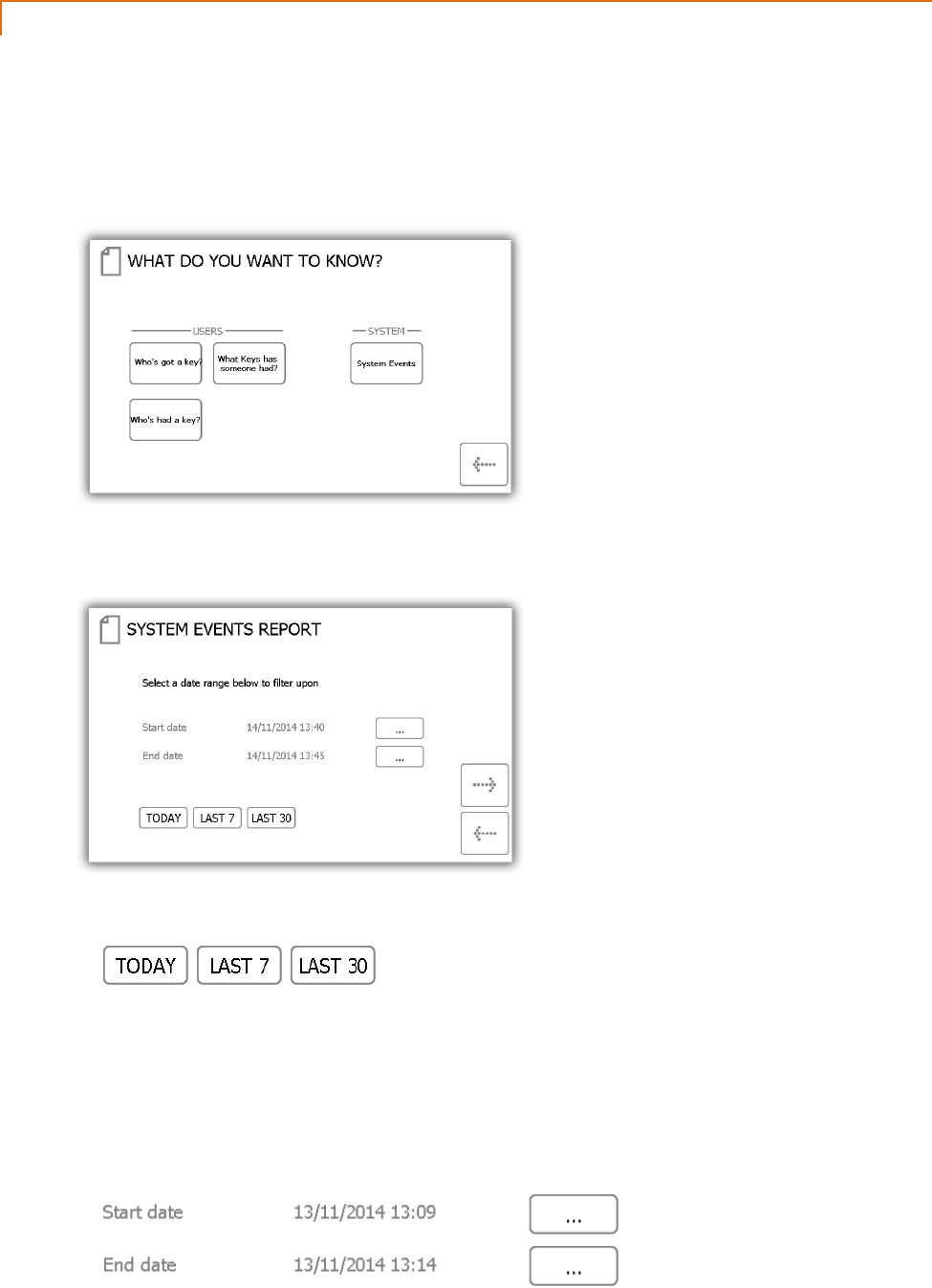
V1.2 09/01/15 UD0130 Page 39 of 63
4.5.4 SYSTEM EVENTS
This report will allow you to see all system related events e.g. admin access, reports access, door opened manually
etc.
1. From the admin menu select the reports button.
2. In the System category, select the ‘System Events’ button.
3. Next you will need to filter your results by selecting a data range. You can manually enter a start and end
date or use the pre-set buttons at the bottom to automatically enter the date range for you.
The pre-set buttons will automatically select the date range for you as follows...
The ‘Today’ button will provide data for selected report beginning at 00:00 of today’s date and end
at the current time you are running the report.
The ‘Last 7’ button will provide data for the selected report from the last seven days.
The ‘Last 30’ button will provide data for the selected report from the past 30 days.
To manually filter the date range, select the button next to the start or end date.
A scrollable control will now allow you select the exact date and time you wish to run the report on.
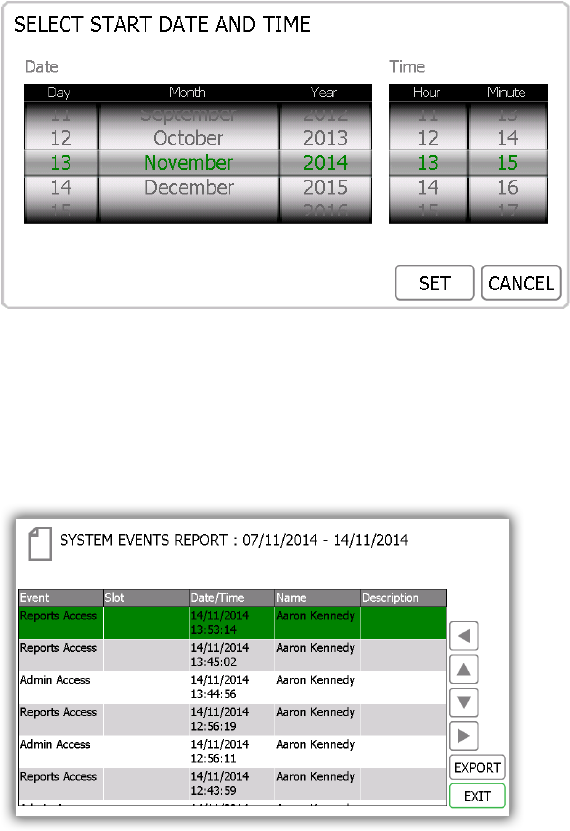
V1.2 09/01/15 UD0130 Page 40 of 63
8. Once you have selected your desired date range, click the forward button.
9. The report will now generate and display all the events that have happened at the system between the
selected date range. E.g. Report Access, Admin Access, Door Open, Door Closed, USB Inserted etc.
NOTE: The key position is noted at the top of the page each time the report is run. E.g. position 1.
10. You can export this information to a USB memory stick if you wish by clicking the Export button. Please
review the Exporting Reports topic at the end of this section for more details.
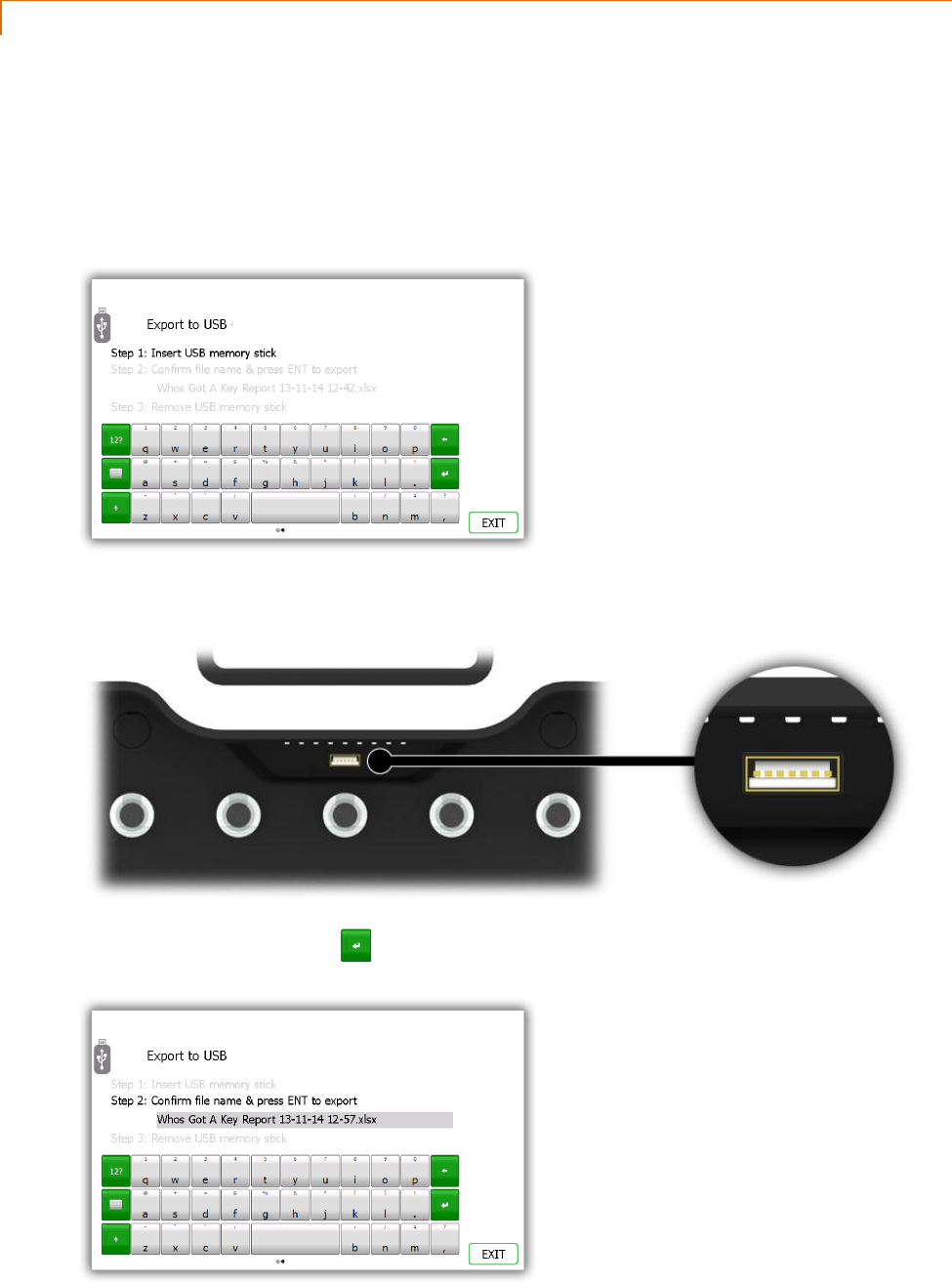
V1.2 09/01/15 UD0130 Page 41 of 63
4.5.5 EXPORTING REPORTS
Once you have run a report you can export the data to a USB memory stick.
1. Run a report as instructed in the previous sections.
2. On the results page there is a button in the bottom right hand called Export.
3. Click the Export button and a new screen will appear prompting you to enter a USB memory stick.
4. Insert a USB memory stick into the slot on the system.
5. Type a filename and select enter to begin the exporting process.
NOTE: Do note remove the memory stick whilst the data is transferring. You may corrupt or even loose
the data.
6. Once the data is finished transferring to the USB memory stick, a message will appear informing you that you
can remove it from the system.
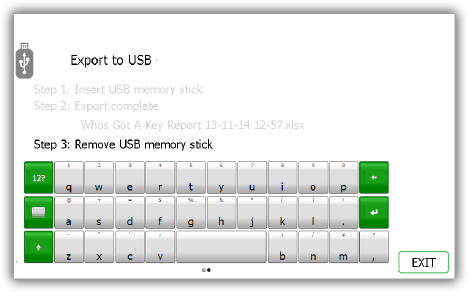
V1.2 09/01/15 UD0130 Page 42 of 63
7. You can now close the door to finish or click the Exit button to go back to the Reports menu.
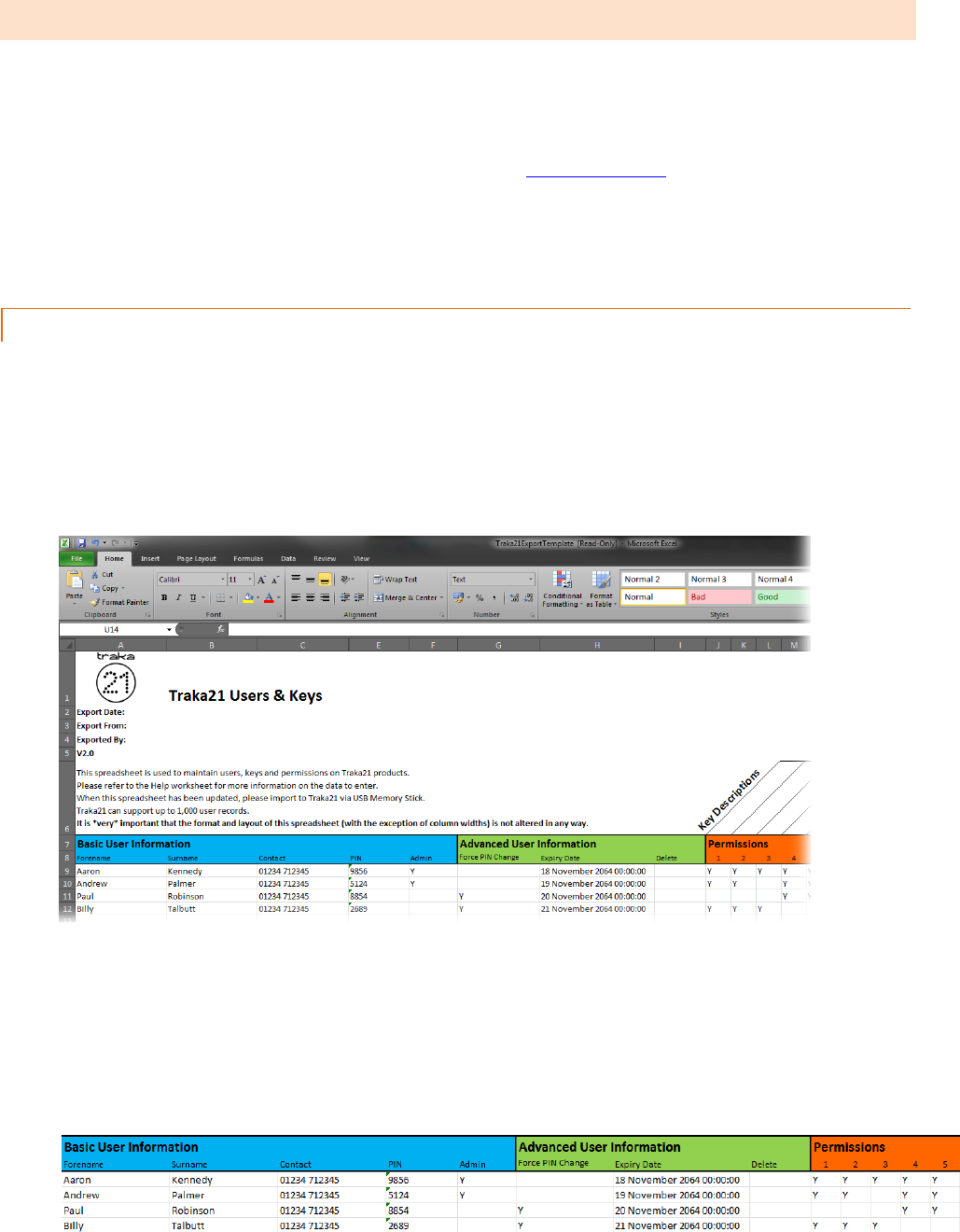
V1.2 09/01/15 UD0130 Page 43 of 63
4.6 IMPORT
It is possible to export and import users key descriptions and permissions to a USB memory stick from the Traka 21
application. The import feature is useful if you wish to add large lists of users or keys in one go.
To use the import feature, you would first need to enter all the required user/key details into a Traka Spreadsheet. To
obtain the Spreadsheet you can download it at the Traka21 website www.traka21.com. Alternatively you can export
your current user/key lists and use the Spreadsheet that provides you with. Please review the section ‘Export 4.7’ for
more details.
NOTE: Traka21 can support up to one thousand (1000) users.
4.6.1 ENTERING DETAILS INTO THE SPREADSEET
This Spreadsheet covers user, key descriptions and permissions details. You don’t need to fill in all the information; it’s
there to be filled in if required.
1. Download or export the Spreadsheet as mentioned above in section ‘Export 4.7’.
2. Open the Spreadsheet on a PC.
3. You can enter all the users’ details here as well as the systems key details.
User & Security Details
Enter all the relevant information as you usually would. For the admin column simply put a capital ‘Y’ if the user
is to have admin permissions, leave it blank if you wish them to remain a standard user.
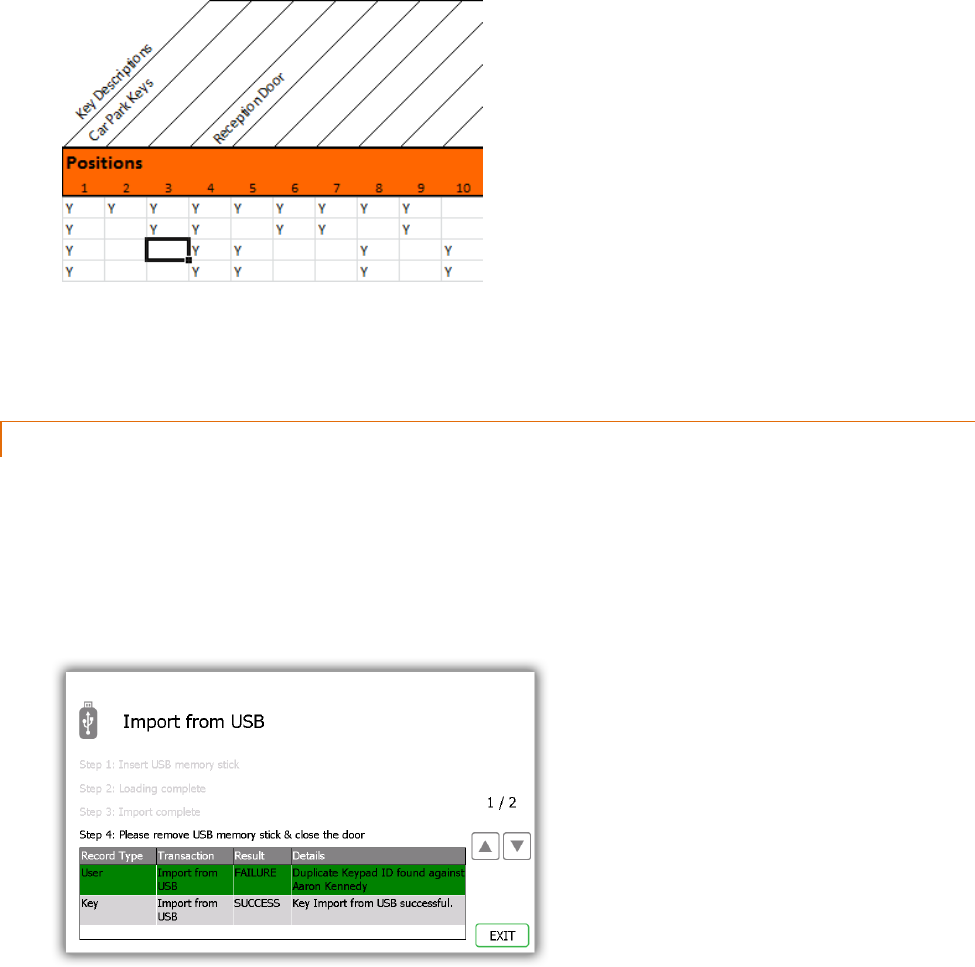
V1.2 09/01/15 UD0130 Page 44 of 63
Key Permissions
To grant a user access to a key simply put a ‘Y’ in the corresponding column. You can also assign a description to
a key by double clicking above the desired position and entering a description of your choice.
4. When finished save the Spreadsheet onto a memory stick.
4.6.2 FAQ’S
Overwriting Users – When you enter a user’s details into the Spreadsheet and that user already exists in the Traka21,
the user credentials from the Spreadsheet will be taken as the most recent edits and will overwrite the systems
information.
Duplicate PIN’s – If a user being imported has the same PIN as a user that already exists in the system, the import will
fail. The user that already exists in the system will be kept and the attempted import user will be rejected.
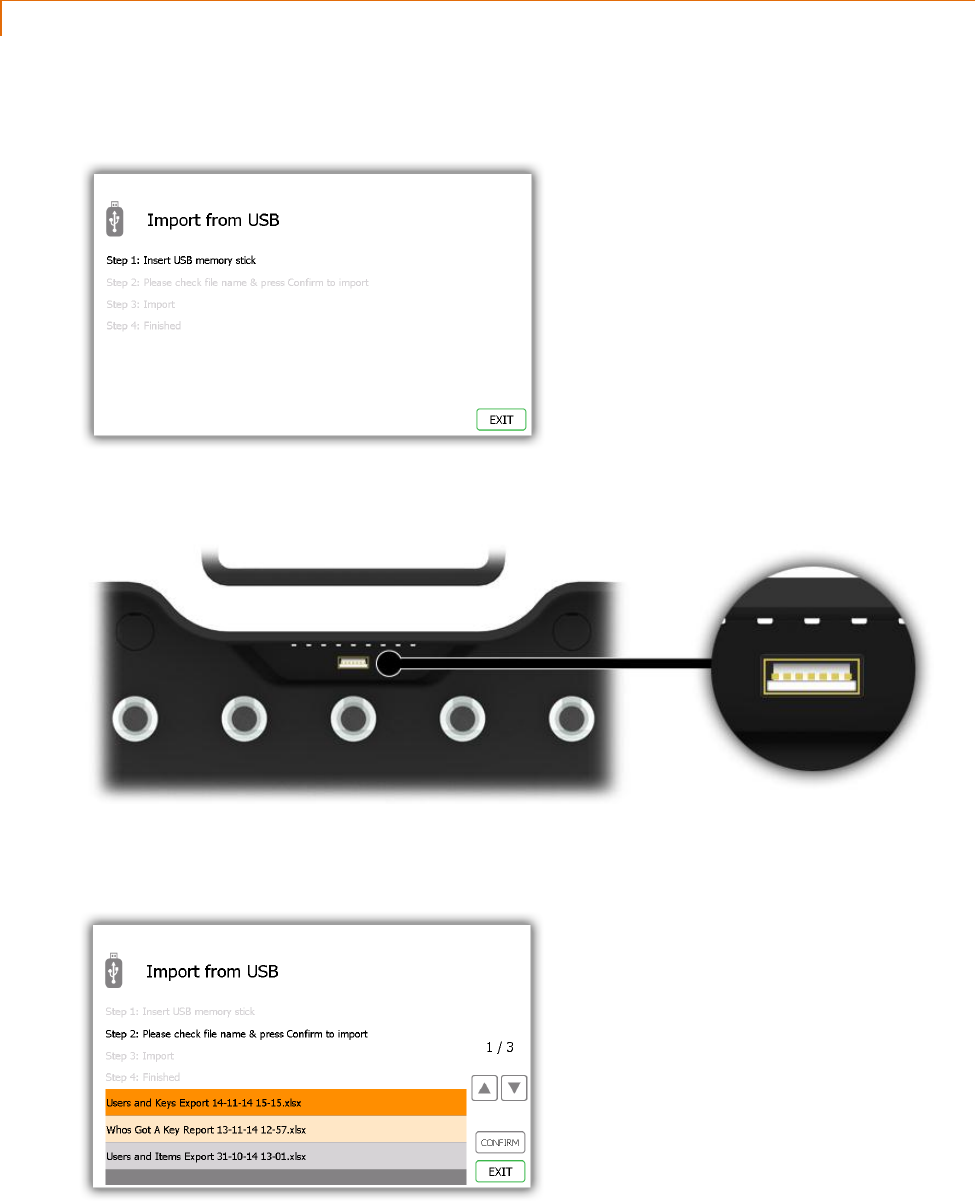
V1.2 09/01/15 UD0130 Page 45 of 63
4.6.3 IMPORTING THE INFORMATION TO TRAKA21
1. Navigate to the admin menu and select the import button.
2. Insert the USB stick into the system.
3. Traka21 will display a list of compatible files on the USB stick and prompt you to select one. Make your
selection and click confirm.
4. The system will ask if you would like to import the new data into the system. Click Yes.
NOTE: This will overwrite any information in the system.
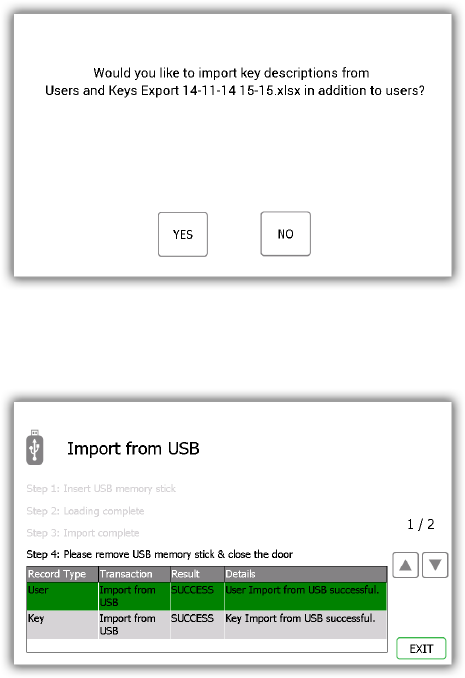
V1.2 09/01/15 UD0130 Page 46 of 63
5. Once complete the table will display the records that were imported and if it was a success. All the new
users/key details will now be in the Traka21 system. You can now remove the USB memory stick.
6. Click the exit button to go back to the admin menu. From there click exit again to be taken back to the login
screen.
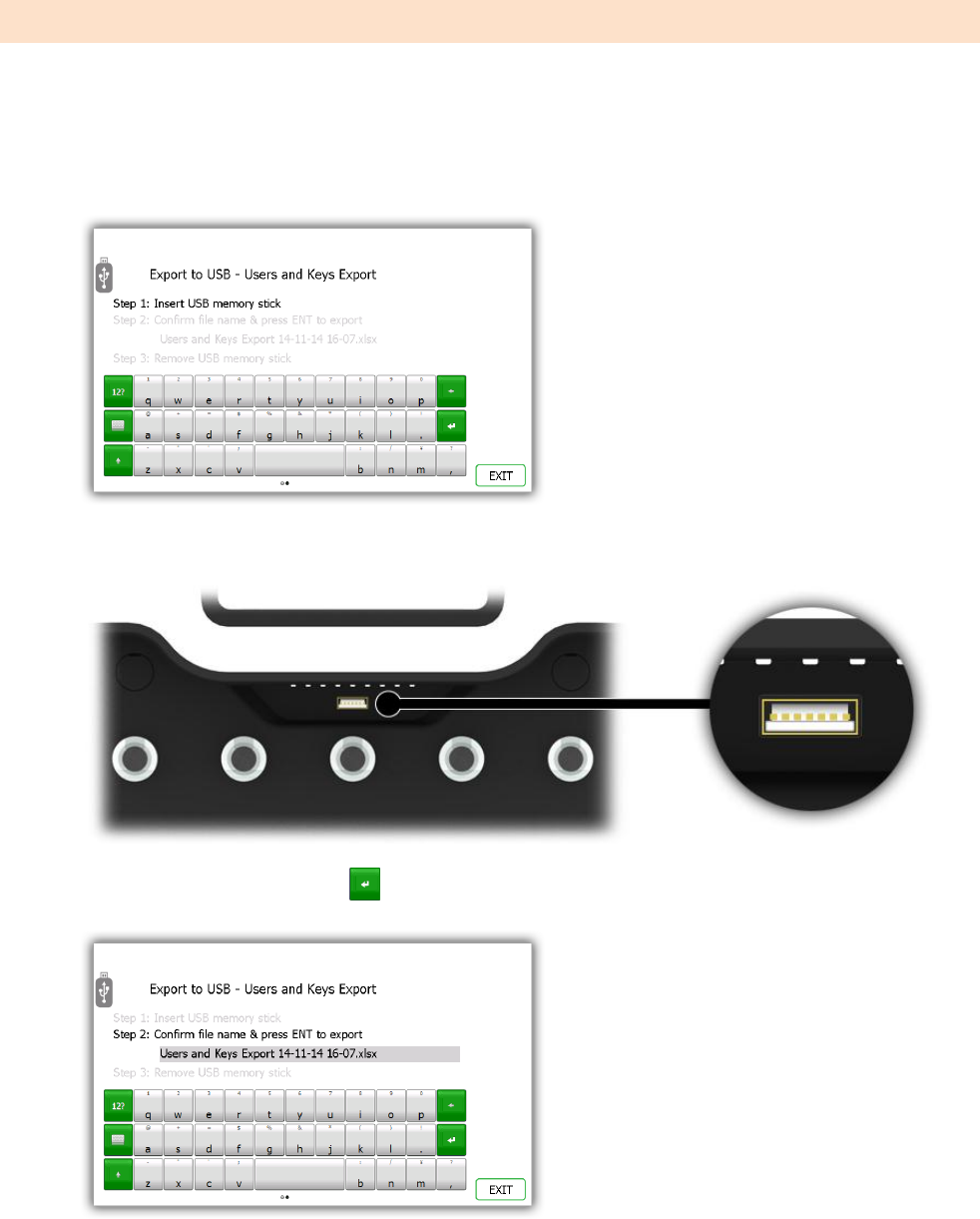
V1.2 09/01/15 UD0130 Page 47 of 63
4.7 EXPORT
It is possible to export and import users to a USB memory stick from the Traka 21 application. When using the export
feature, Traka21 it will export the current user and key details to a Spreadsheet on a USB memory Stick. The
Spreadsheet can then be updated and imported to update the system.
1. Navigate to the admin menu and select the export button.
2. Insert the USB stick into the system.
3. Type a filename and select enter to begin the exporting process.
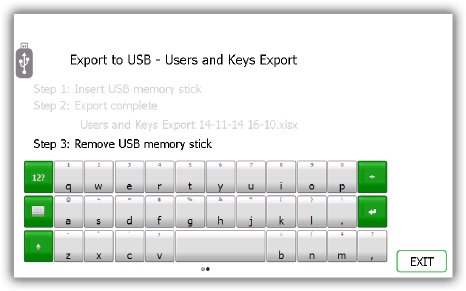
V1.2 09/01/15 UD0130 Page 48 of 63
4. Once the exporting process has finished you can remove the USB stick.
5. Click the exit button to go back to the admin menu, from there click exit again to be taken back to the login
screen.
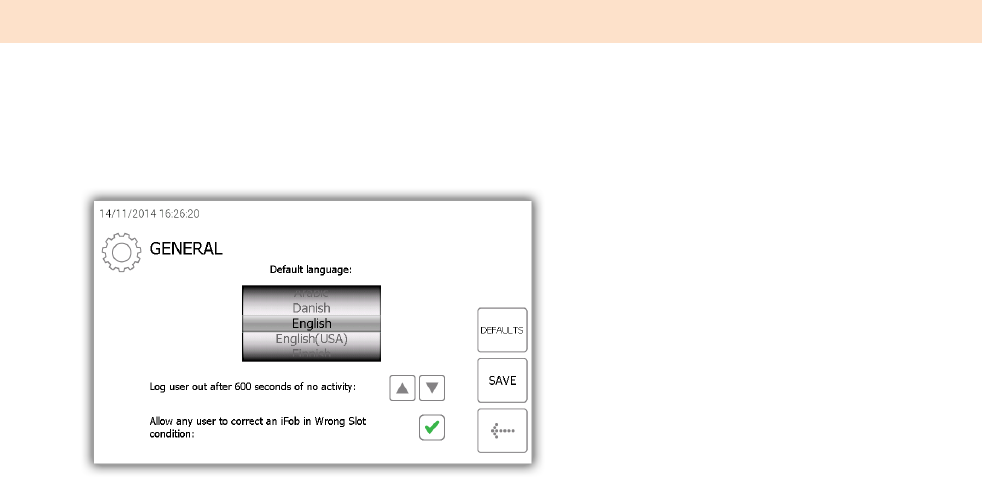
V1.2 09/01/15 UD0130 Page 49 of 63
4.8 GENERAL
The general screen allows you to set three common settings of the system, the default language, system log out time
and iFob in wrong slot condition.
1. From the admin menu select the general button.
2. From here you can select the following options.
Default language
Simply scroll through to find the desired langue.
Log user out after xx or no activity
This feature allows you to define the amount of time it takes for the system to log the user out after no
activity. Using the directional arrows select the appropriate time in increments of 1 second.
Allow any user to correct an iFob in Wrong Slot
iFob in wrong slot condition – By default this option is enabled which means if an iFob is in the wrong
position, any user, not just an administrator, will be asked to move the incorrect iFob to the correct position
even is they don’t normally have permission to take the key.
3. Click the save button.
4. To set you system back to the default setting click the default button.
5. When finished click the back button to go back to the admin menu. From there click the exit button to go
back to the login screen.
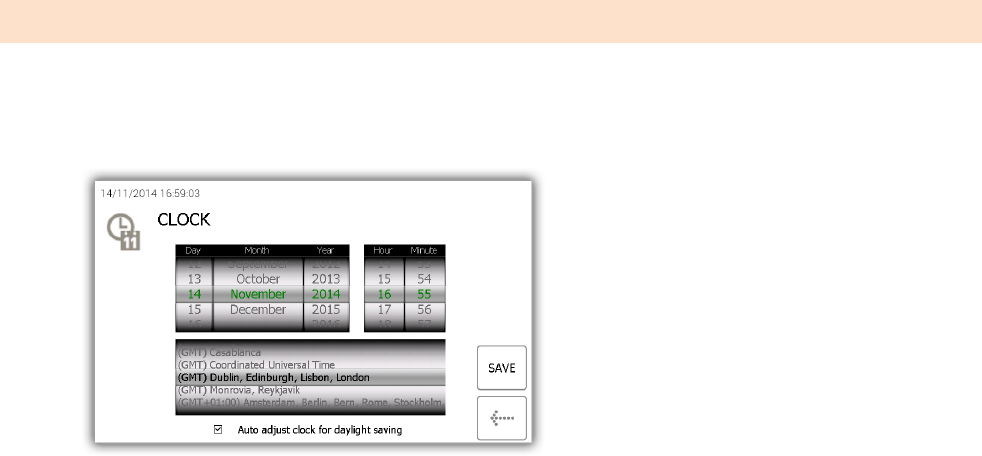
V1.2 09/01/15 UD0130 Page 50 of 63
4.9 TIME
Here you can set the date and time of the system.
1. From the admin menu select the time button.
2. To change the date and time simply scroll through the menus and click the save button to keep you changes.
3. When you have finished, click the back button to go to the admin menu. From there click exit to return to the
login screen.
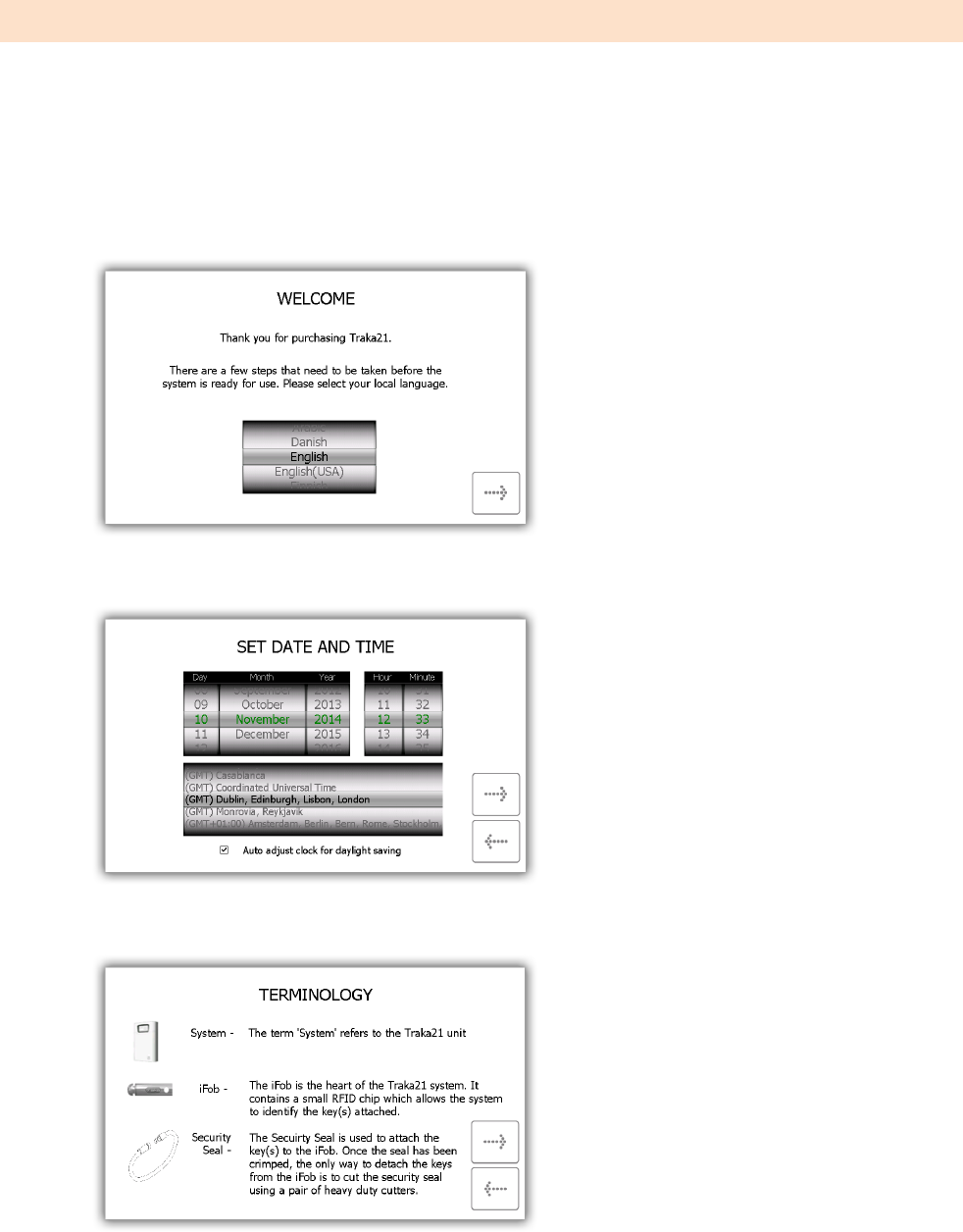
V1.2 09/01/15 UD0130 Page 51 of 63
4.10 SETUP WIZARD
From the admin menu select the setup wizard. The setup wizard option will mimic the initial setup that occurred when
the Traka21 was first switched on. It will allow you to reselect the language and the date & time of the system. It will
also show you all of the information screens you saw when you setting up the system originally.
NOTE: you will not be able to add an admin user in this setup wizard.
1. From the admin menu click the Setup Wizard button.
2. Next reselect the date, time & time zone and click the forward button.
3. The next two pages are a breakdown of Traka21 terminology. Read this page and click the forward button.
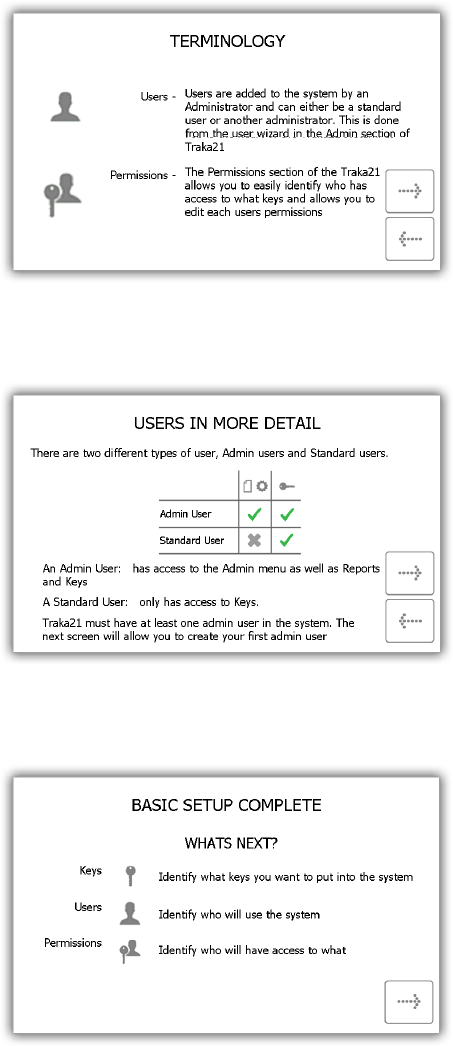
V1.2 09/01/15 UD0130 Page 52 of 63
4. Read the second terminology page and click the forward button.
5. This page explains the difference between standard and admin users. Read this page and click the forward
button.
6. The basic setup is now complete. This window will give instructions on what you need to do next. Read this
then click the forward button.
7. The final page of the setup wizard will show how to login to the system and navigate to the administration
menu. Click the forward button to begin.
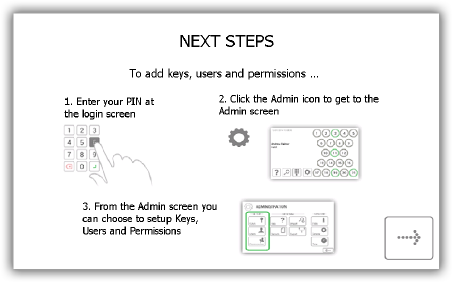
V1.2 09/01/15 UD0130 Page 53 of 63
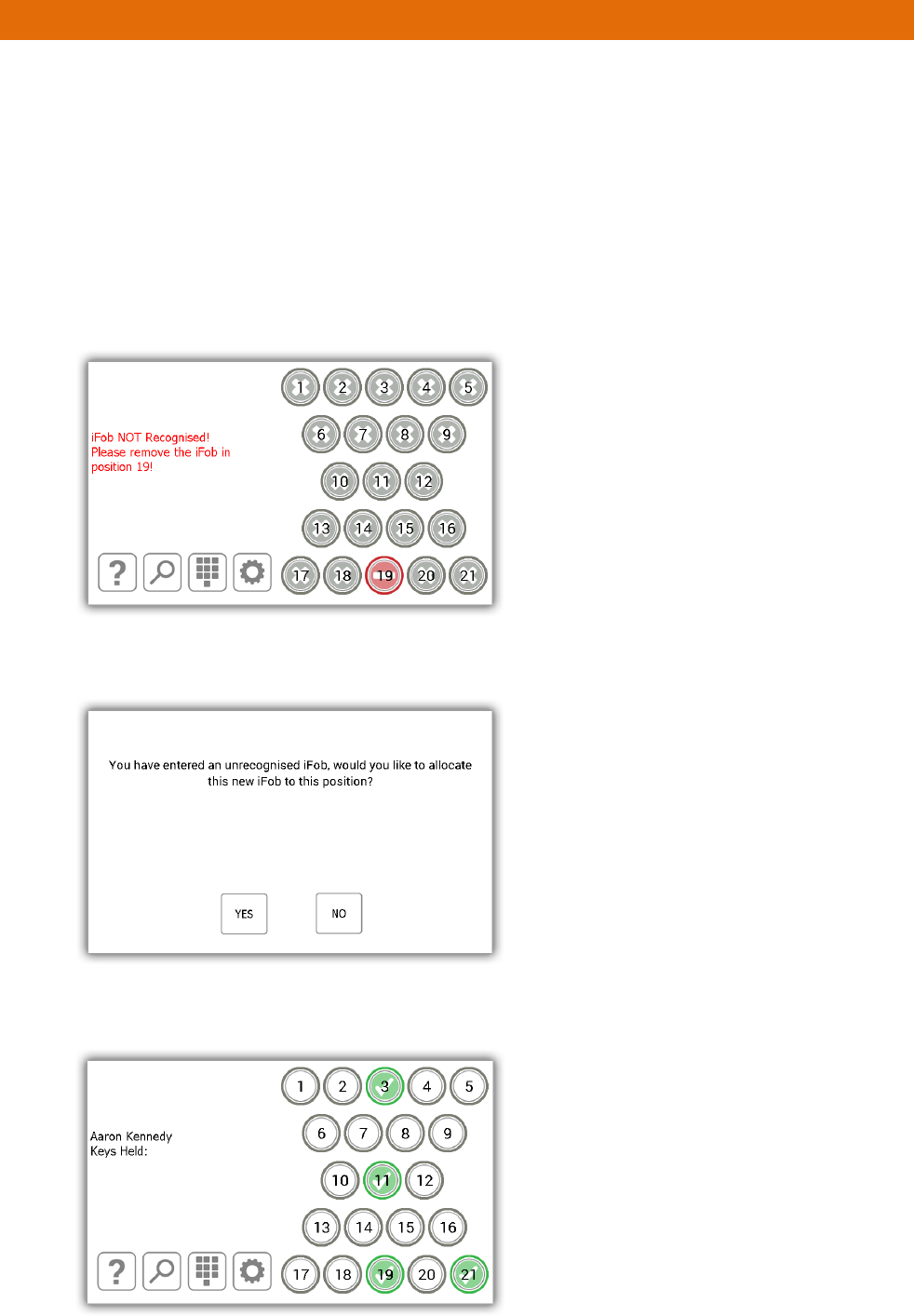
V1.2 09/01/15 UD0130 Page 54 of 63
5. REPLACING IFOBS
If the need to replace an iFob should arise i.e. an iFob has been broken or lost, you should follow the steps below to to
replace the old iFob with a new one.
NOTE: As the Traka21 is provided with 21 iFobs you will need to order more iFobs from Traka or your
distributor/supplier.
1. An administrator will need to login to the system.
2. Insert the new iFob into the position you want to assign it to.
3. The system will ask if you want to assign this new iFob to the position.
4. Click Yes, and the iFob will immediately become usable.
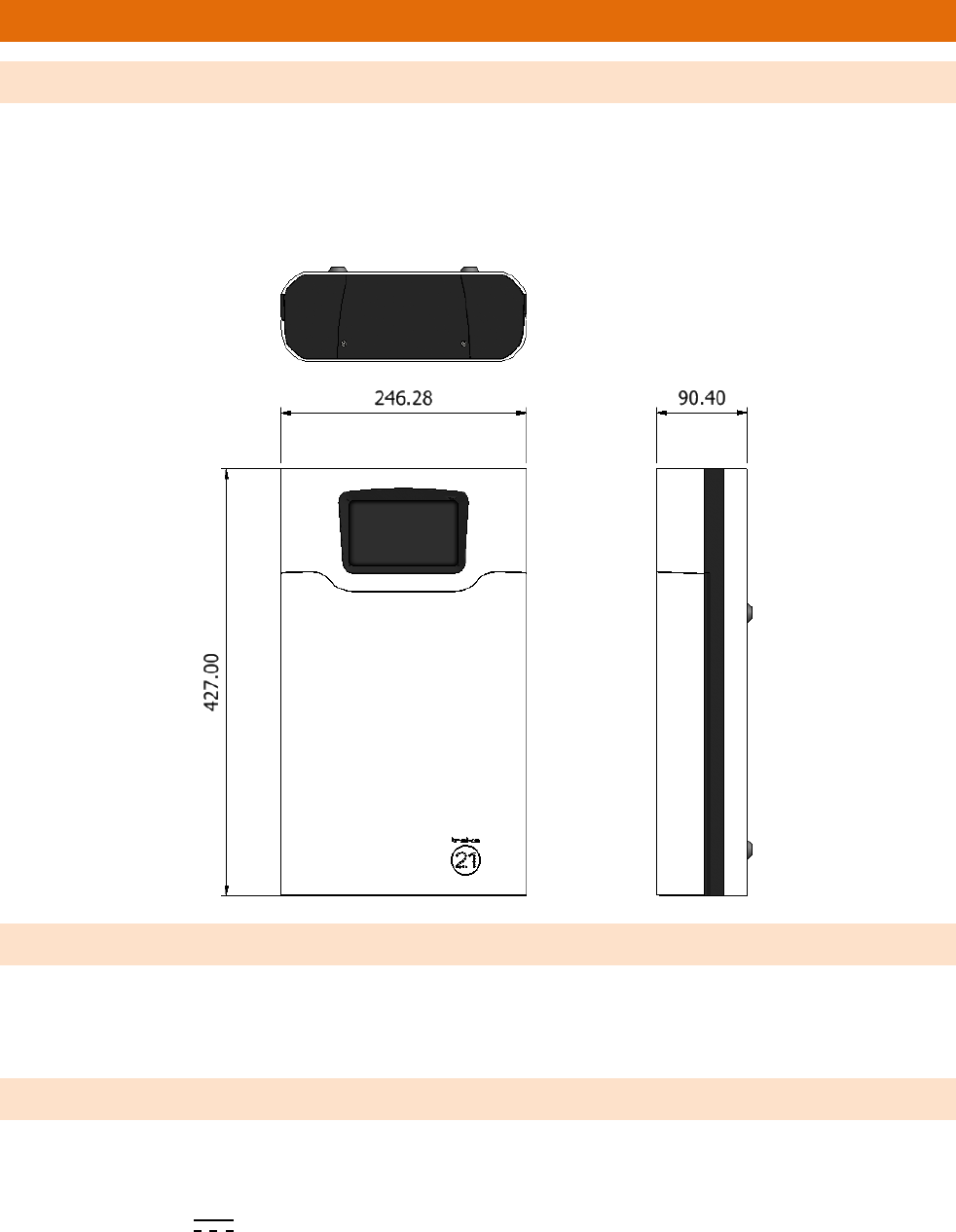
V1.2 09/01/15 UD0130 Page 55 of 63
6. TRAKA21 TECHNICAL DETAILS
6.1 SYSTEM SIZE
Please see below a list and diagram of the Traka21’s height, width and depth.
Height – 427.00mm
Width – 246.28mm
Depth – 90.40mm
6.2 SYSTEM WEIGHT
Traka21 with iFobs (without keys or optional battery) is 3.94Kg. Optional battery is an additional 0.63 Kg
6.3 POWER DETAILS
Traka21 uses a 15 ~ 24W AC-DC Single Output power supply. Please see the technical details below.
Input – 100-240VAC, 50-60Hz, 0.7A
Output – 15V 1.6A
Safety Standards – UL60950-1, CSA C22.2, TUV EN60950 -1, CCC GB4943 approved
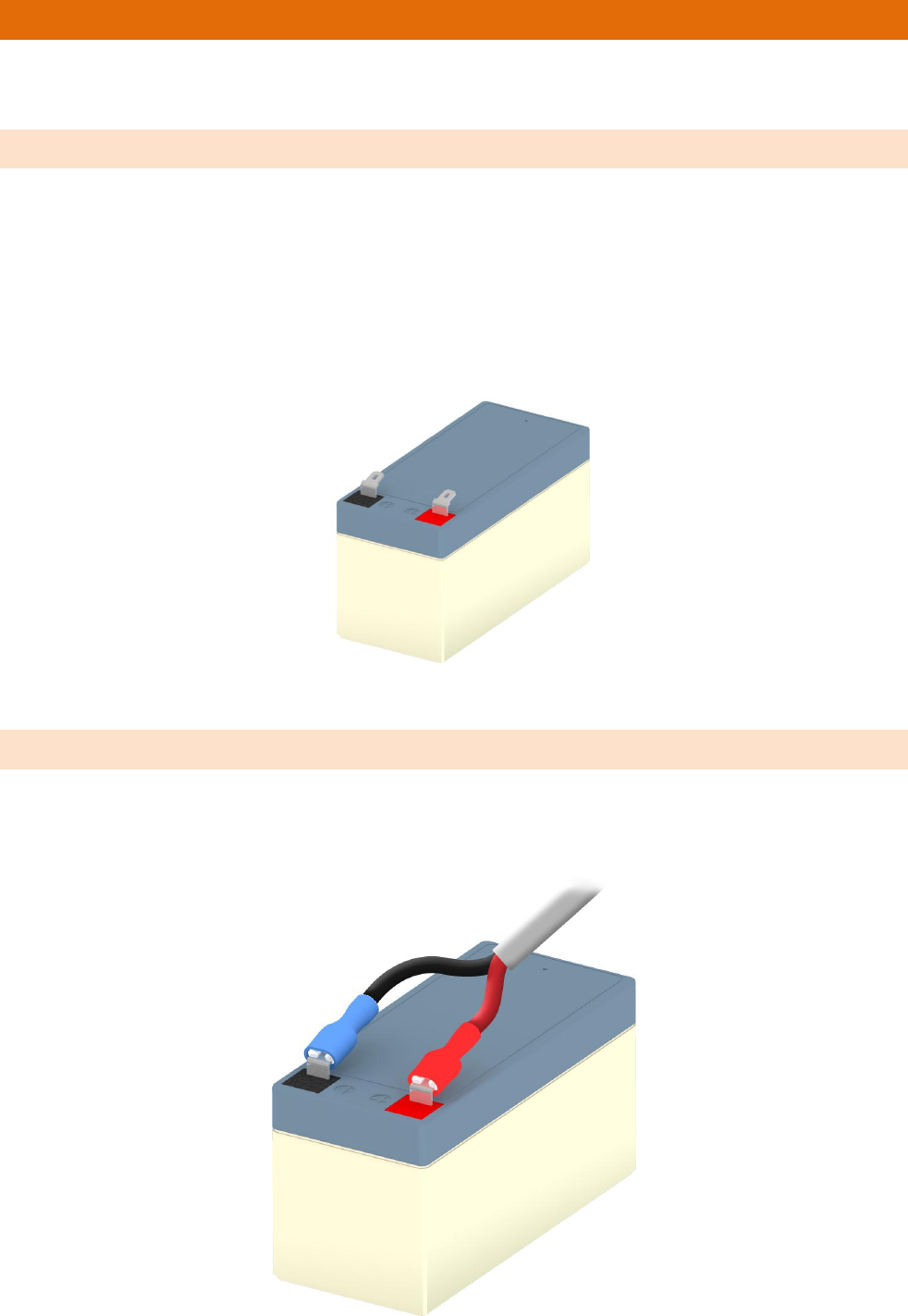
V1.2 09/01/15 UD0130 Page 56 of 63
7. BACKUP BATTERY
The Traka21 is supplied with an optional backup battery with systems inside the UK. A system outside the UK will need
to source a battery using the information in the Battery Specification section below.
7.1 BATTERY SPECIFICATION
The backup battery is kept charged by the system when running from the mains so that it is ready to be used should
there be a power failure.
The service life of the battery is typically 5 years. Should the battery require replacing then it is important that it is
replaced with the correct type! The battery can be sourced directly from Traka – the following battery is
recommended:
YUASA NP1-.2-12 12V, 1.2AH Valve Regulated Lead Acid Battery.
7.2 BATTERY CONNECTION CODE
Connect the Red Connector to the Red Battery Terminal (indicated with the + symbol)
Connect the Blue Connector to the Black Battery Terminal (indicated with the – symbol)
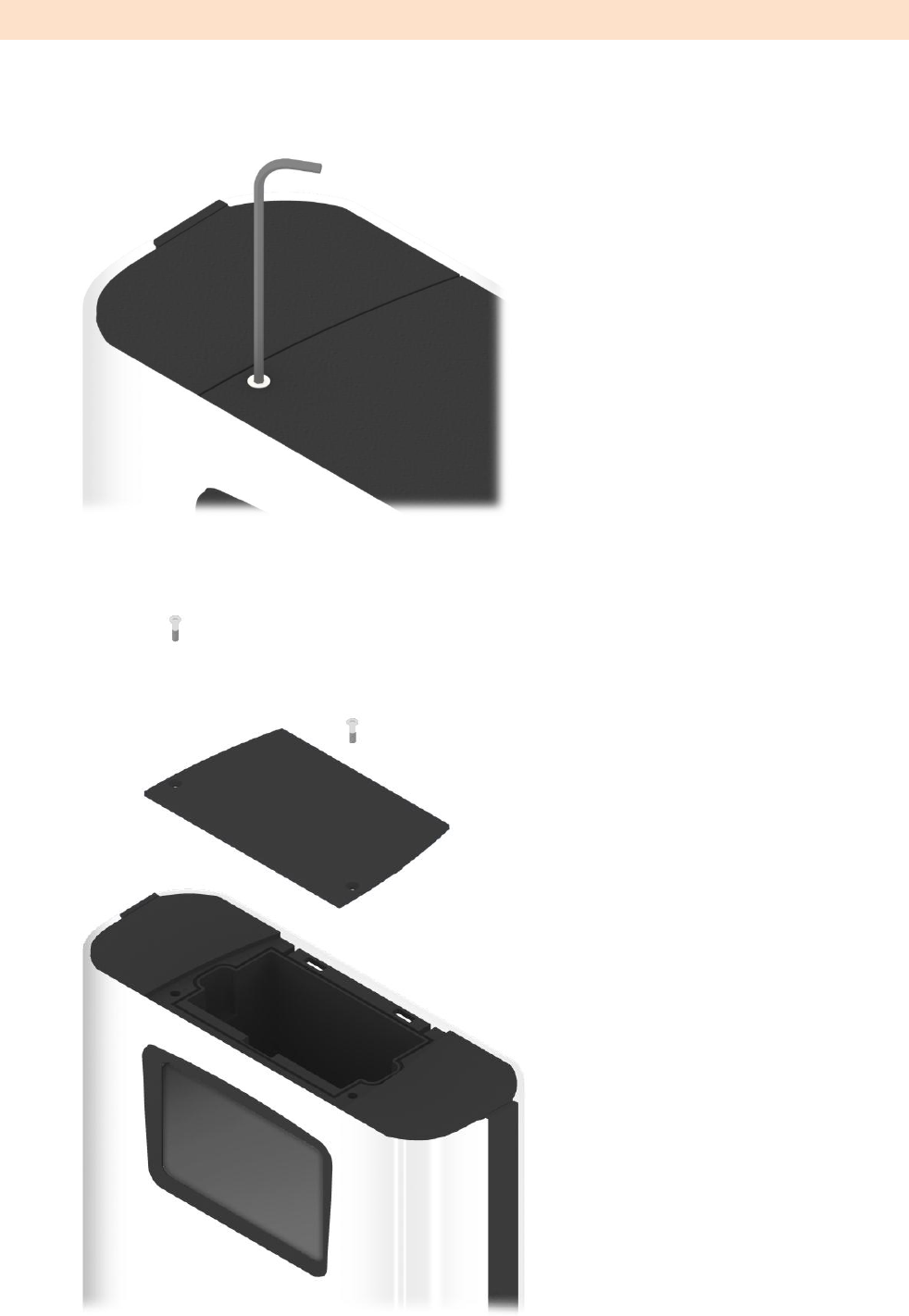
V1.2 09/01/15 UD0130 Page 57 of 63
7.3 BATTERY INSTALLATION
To install the battery you will need to remove the top panel of the system.
1. Unscrew the cover plate using a 2mm Allen Key.
2. Remove the cover plate and screws.
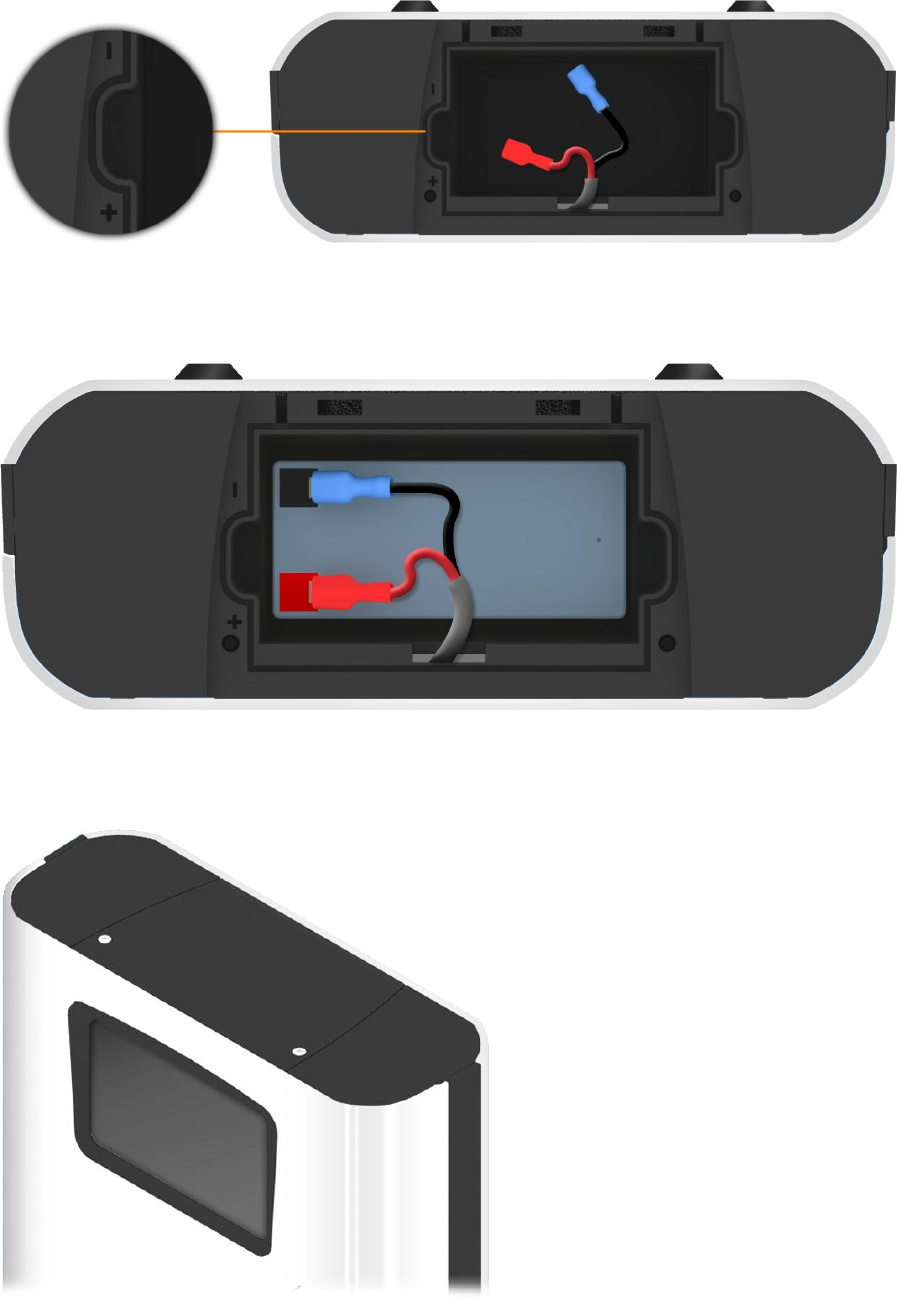
V1.2 09/01/15 UD0130 Page 58 of 63
3. Place the battery inside the compartment. Inside the system, embedded into the material are + and –
symbols to help you properly orientate the battery correctly. The red terminal of the battery should face the
+ and the black terminal should face the -.
4. Connect the battery to the battery cable. Use the connection code in the section above for guidance.
5. Replace the cover and screws using the 2mm Allen Key.
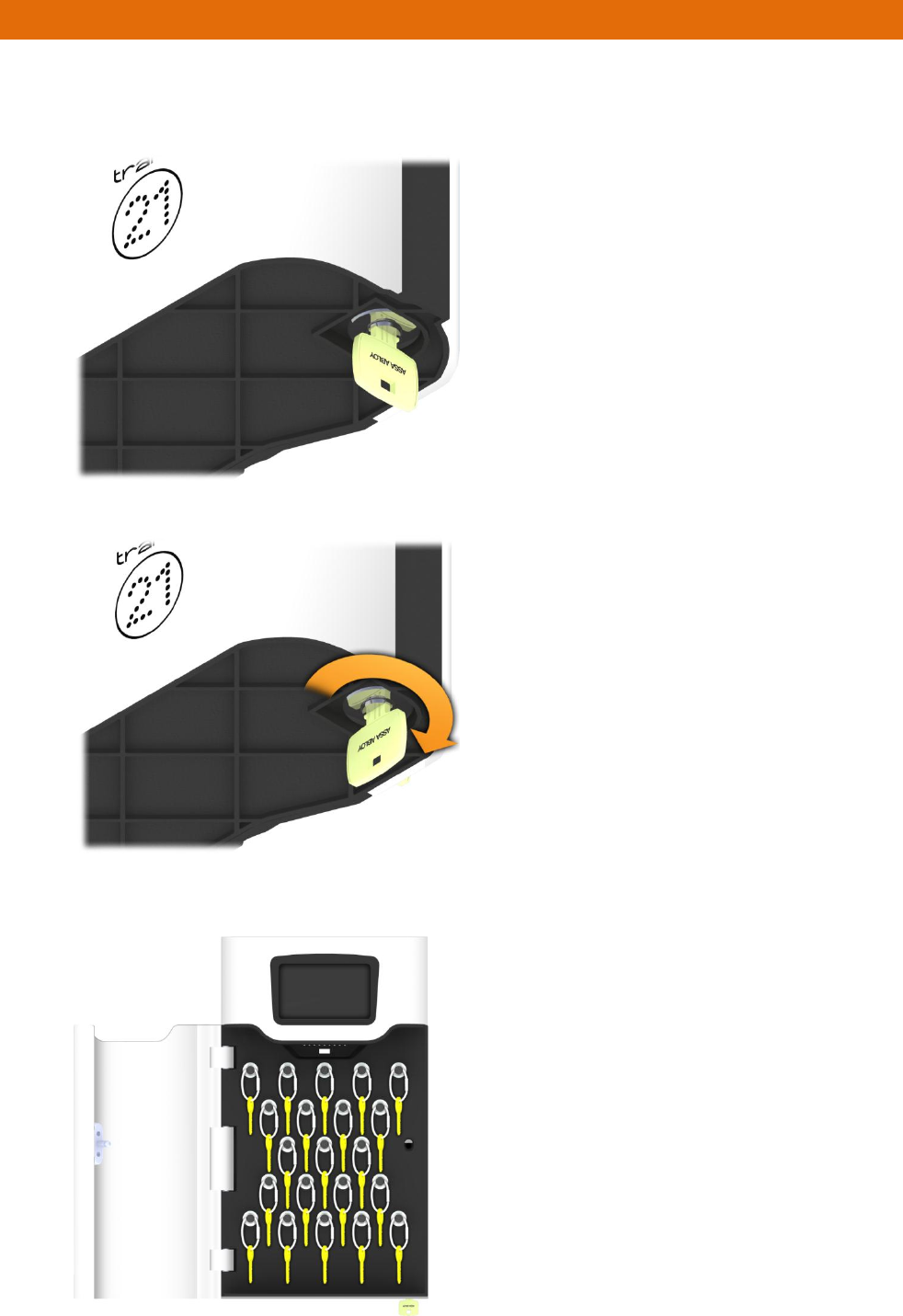
V1.2 09/01/15 UD0130 Page 59 of 63
8. HOW TO REMOVE KEYS IN A POWER FAILURE
If there should be a power failure and your system does not have a battery. You will need to manually access and
remove the keys.
1. Insert the override key into the bottom of the system.
2. Turn the key 90° counter clockwise.
3. The door will now open, granting you access to the keys.
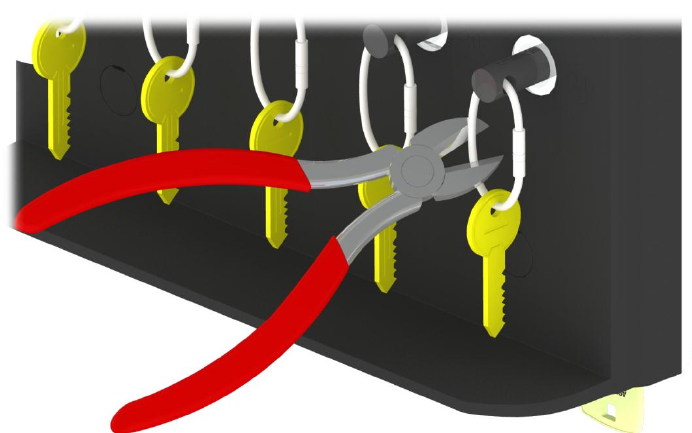
V1.2 09/01/15 UD0130 Page 60 of 63
4. Using a pair of heavy duty cutters, you will need to cut the security seals for the keys you require.
5. Remove the Keys from the security seal.
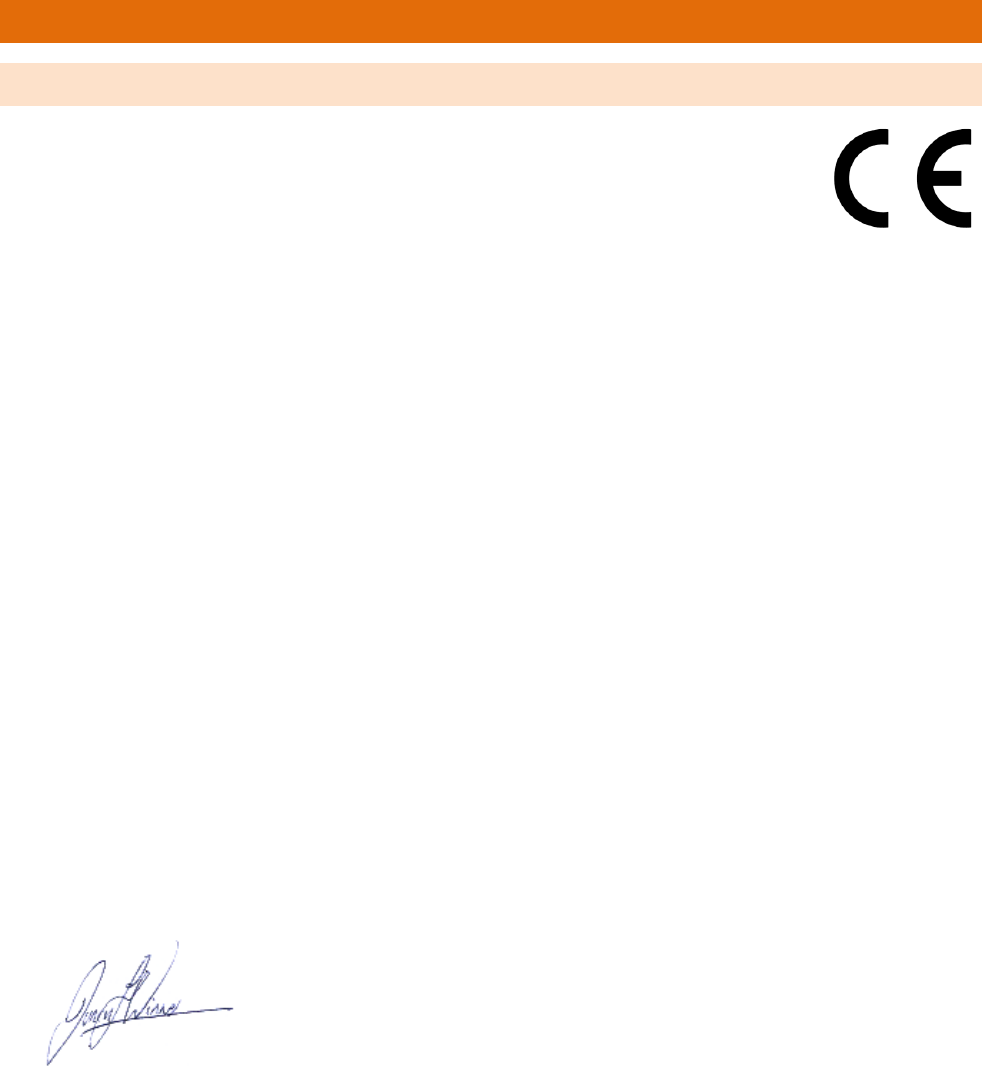
V1.2 09/01/15 UD0130 Page 61 of 63
9. REGULATORY NOTICES
9.1 DECLARATION OF CONFORMITY
WE
Traka
30 Stilebrook Road
Olney
Bucks
MK46 5EA
UK
DECLARE UNDER OUR SOLE RESPONSIBILITY THAT THE PRODUCTS
Traka21
TO WHICH THIS DECLARATION RELATES IS IN CONFORMITY WITH THE FOLLOWING STANDARD(S) OR OTHER
NORMATIVE DOCUMENT(S)
IEC/UL/EN 60950-1 Safety Testing
EN 301 489-1/3 EMC Testing
EN 302 291 RFID Testing
FCC 47CFR Part 15B / IC RSS-GEN (ICES-003) Radiated & Conducted Emissions
FCC 47CFR Part 15.225 / IC RSS-210 RFID Testing
Restriction of Certain Hazardous Substances (RoHS)
(WHERE APPLICABLE) FOLLOWING THE PROVISIONS OF DIRECTIVES
R&TTE 1999/5/EC, 2006/95/EC and 2002/95/EC.
PLACE OF ISSUE: UK
DATE OF ISSUE: WIP
Signed:-
Duncan Winner
Technical Director
Traka
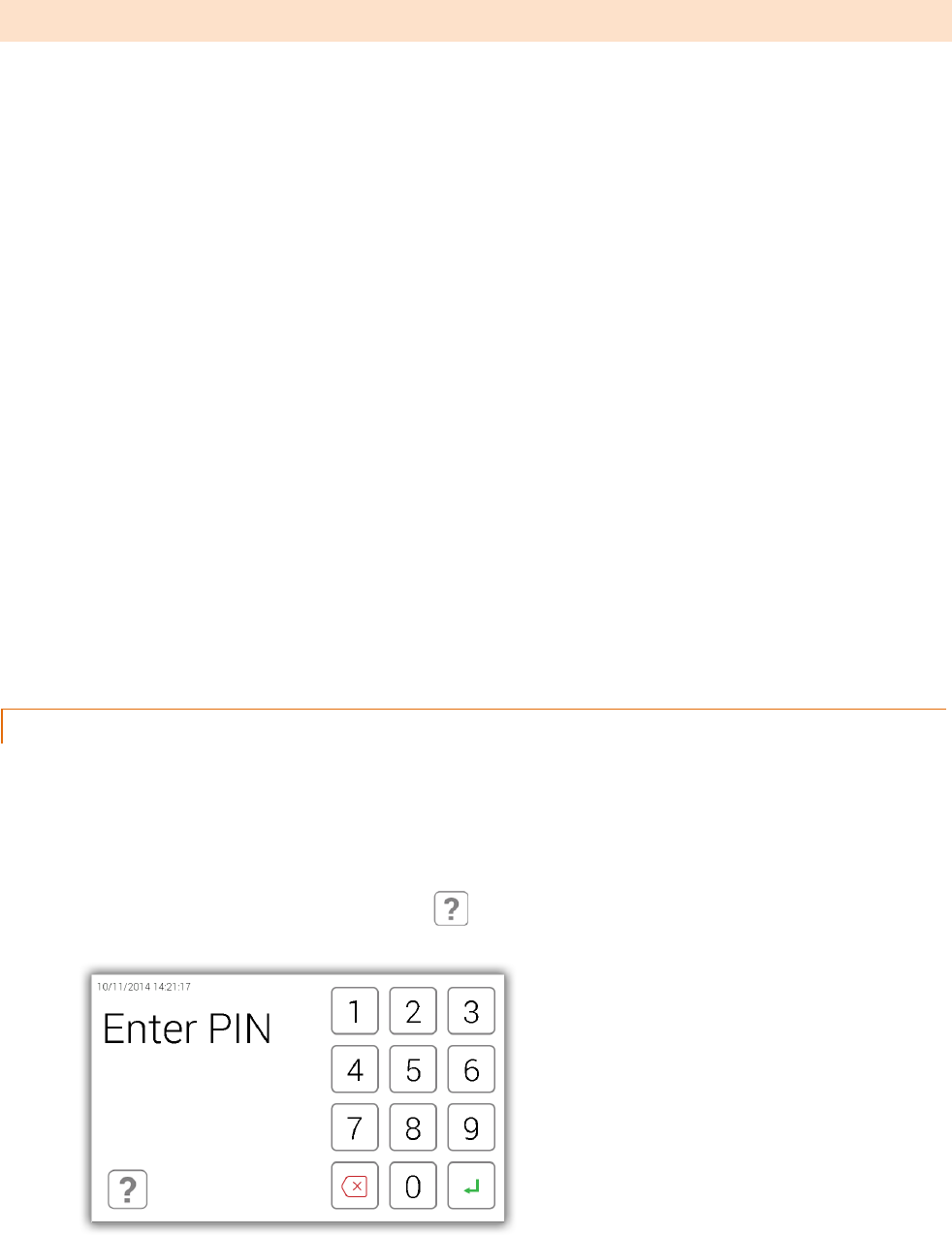
V1.2 09/01/15 UD0130 Page 62 of 63
9.2 FCC COMPLIANCE
This device complies with Part 15 of the FCC Rules. Operation is subject to the following two conditions: (1) this
device may not cause harmful interference, and (2) this device must accept any interference received, including
interference that may cause undesired operation.
Changes or modification not expressly approved by the manufacturer could void user’s authority to operate the
equipment.
NOTE: This equipment has been tested and found to comply with the limits for a Class B digital device, pursuant to
part 15 of the FCC Rules. These limits are designed to provide reasonable protection against harmful interference
in a residential installation. This equipment generates, uses and can radiate radio frequency energy and, if not
installed and used in accordance with the instructions, may cause harmful interference to radio communications.
However, there is no guarantee that interference will not occur in a particular installation. If this equipment does
cause harmful interference to radio or television reception, which can be determined by turning the equipment
off and on, the user is encouraged to try to correct the interference by one or more of the following measures:
Reorient or relocate the receiving antenna.
Increase the separation between the equipment and receiver.
Connect the equipment into an outlet on a circuit different from that to which the receiver is connected.
Consult the dealer or an experienced radio/TV technician for help.
FCC ID: 2ADNX-KC10156
Model: KC-1-0156
9.2.1 INFORMATION IN THE TRAKA21 APPLICATION
FCC regulatory information may be accessed directly on the product by viewing the appropriate help topic. Any user
can access this information by selecting the help button from the login screen.
1. If the touch screen is black then the system is in power save mode. Simply touch the screen to ‘wake the
system up’
2. From the login screen select the help button
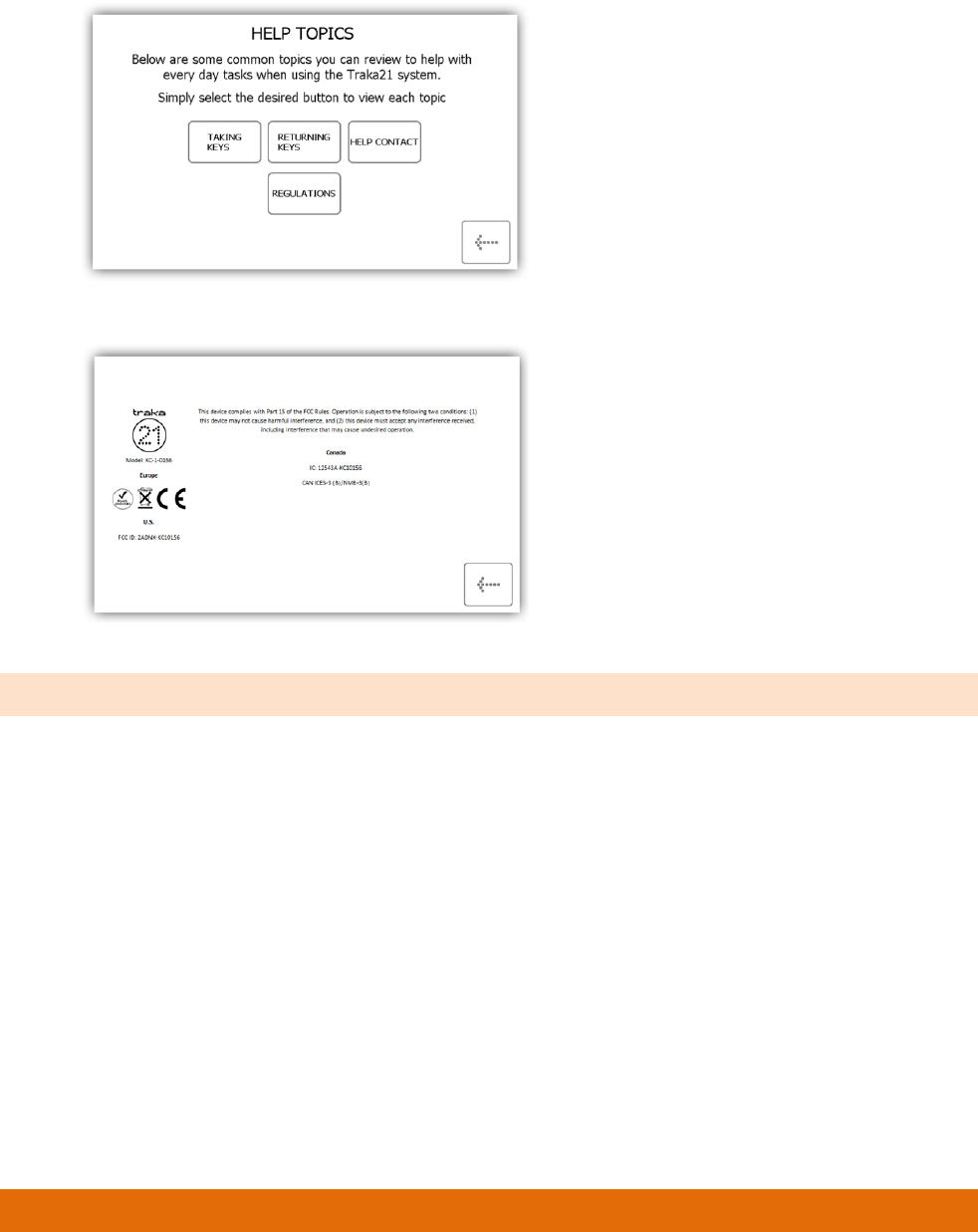
V1.2 09/01/15 UD0130 Page 63 of 63
3. At the help screen there are four options to choose from, select the Regulations button.
4. You will be taken to the FCC compliance page. If you require more information please visit www.traka21.com.
9.3 INDUSTRY CANADA
This Class B digital apparatus complies with Canadian ICES-003.
Cet appareil numérique de la classe B est conforme à la norme NMB-003 du Canada.
IC: 12543A-KC10156
Model: KC-1-0156
This device complies with Industry Canada licence-exempt RSS standard(s). Operation is subject to the following two
conditions: (1) this device may not cause interference, and (2) this device must accept any interference, including
interference that may cause undesired operation of the device.
Le présent appareil est conforme aux CNR d’Industrie Canada applicables aux appareils radio exempts de licence.
L’exploitation est autorisée aux deux conditions suivantes : (1) l’appareil ne doit pas produire de brouillage, et (2)
l’utilisateur de l’appareil doit accepter tout brouillage radioélectrique subi, même si le brouillage est susceptible d’en
compromettre le fonctionnement.
10. TECHNICAL SUPPORT
If you need technical support, please visit the Traka21 website.
www.traka21.com